LG Electronics USA S5300 GSM 900/1800/1900 PCS phone with Bluetooth User Manual S5300 1203
LG Electronics USA GSM 900/1800/1900 PCS phone with Bluetooth S5300 1203
Manual
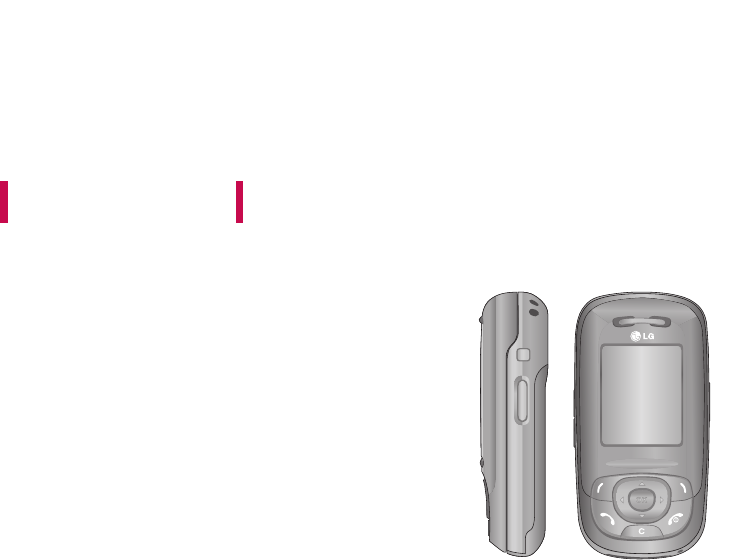
Some of contents in this manual may differ from your
phone depending on the software of the phone or
your service provider.
S5300 USER GUIDE
ENGLISH

Table of Contents
2
Table of Contents
Introduction 6
Guidelines for safe and
efficient use 7
S5300 features 11
Parts of the phone
Display information 15
Getting started 17
Installing the SIM card and
battery
Charging the Battery 18
Disconnecting the adapter 19
Turning your phone
on and off 20
Access codes
Barring password 21
General Functions 22
Making and answering calls
Contacts 26
In-call menu
Multiparty or
conference calls 28
Menu Tree 30
Selecting functions and
options 33
Call register 34
Missed calls
Received calls
Dialled calls
All calls
Delete recent calls
Call charges
Call duration
Call costs 35
GPRS information
Call duration
Data volumes

3
Table of Contents
Address book 36
Contact list
New contact 37
Caller groups
Speed dial 38
Own number
Business card
Settings
Settings 40
Date & Time
Set date
Date format
Set time
Time format
Phone settings 40
Display
Wallpaper
Handset scheme
Greeting note
Backlight timeout 41
Information window
Languages
Call
Call forwarding
Answer mode 42
Send my number
Call waiting
Minute minder
Auto redial 42
Select line
Security settings 43
PIN Code request
Phone lock
Call barring 44
Fixed dial number 45
Change codes
Network
GPRS attach 46
Reset settings
Memory status
Handset memory
Media memory 47
Aide Orange
Communiquer
Orange World
Jeux
Astuces

Table of Contents
4
Camera 48
Take photo
Record video 50
Memory status 51
Messages 52
Create new massage
Tex t
Multimedia 53
Write email message 56
Inbox
Orange Messenger 58
Drafts 62
Mailbox
Outbox
Listen to voice mail 63
Info message
Read 64
Topics
Templates 64
Tex t
Multimedia 65
Business card
Settings
Text messages
Multimedia messages 66
Email 68
Voice mailbox number
Info message
Download messages 69
Memory status 70
Orange World 71
Orange World
Mes Mails
Sonneries/Logos
Jeux
Cinema
Sports
Bookmarks
Settings
Music player 73
MP3 player
Playlist
Settings 74
Table of Contents
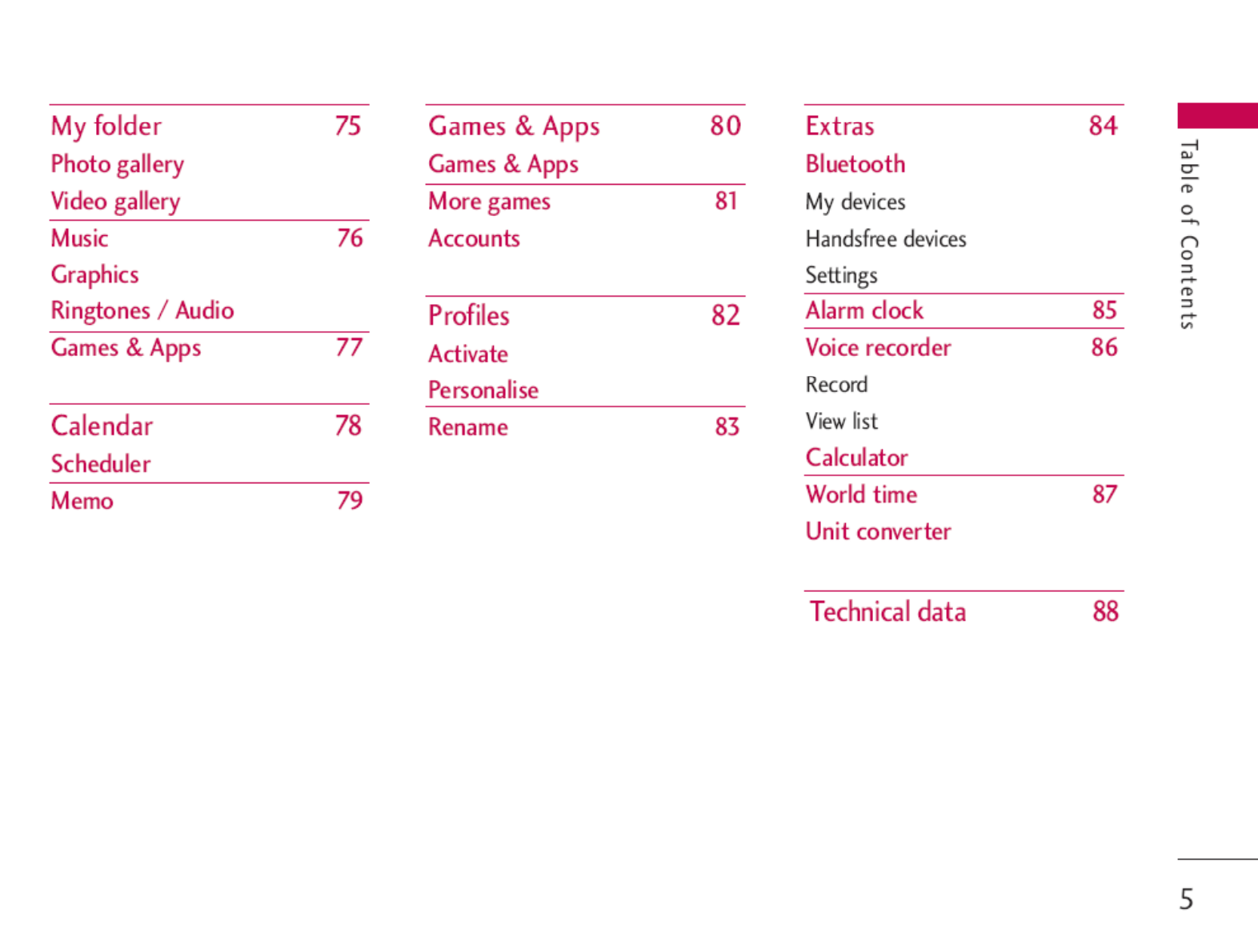
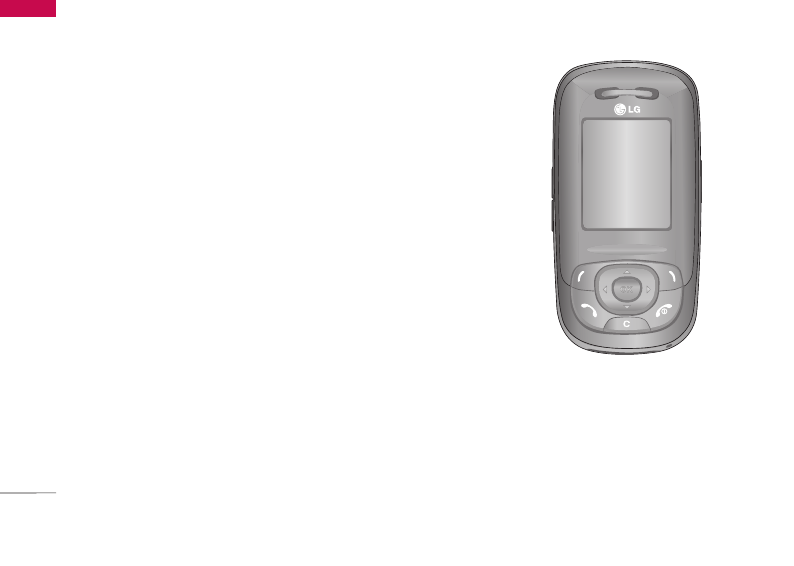
Congratulations on your purchase of the advanced
and compact S5300 mobile phone, designed to
operate with the latest digital mobile communication
technology.
This user’s guide contains important information on
the use and operation of this phone. Please read all
the information carefully for optimal performance
and to prevent any damage to or misuse of the
phone. Any changes or modifications not expressly
approved in this user’s guide could void your
warranty for this equipment.
Introduction
6
Introduction
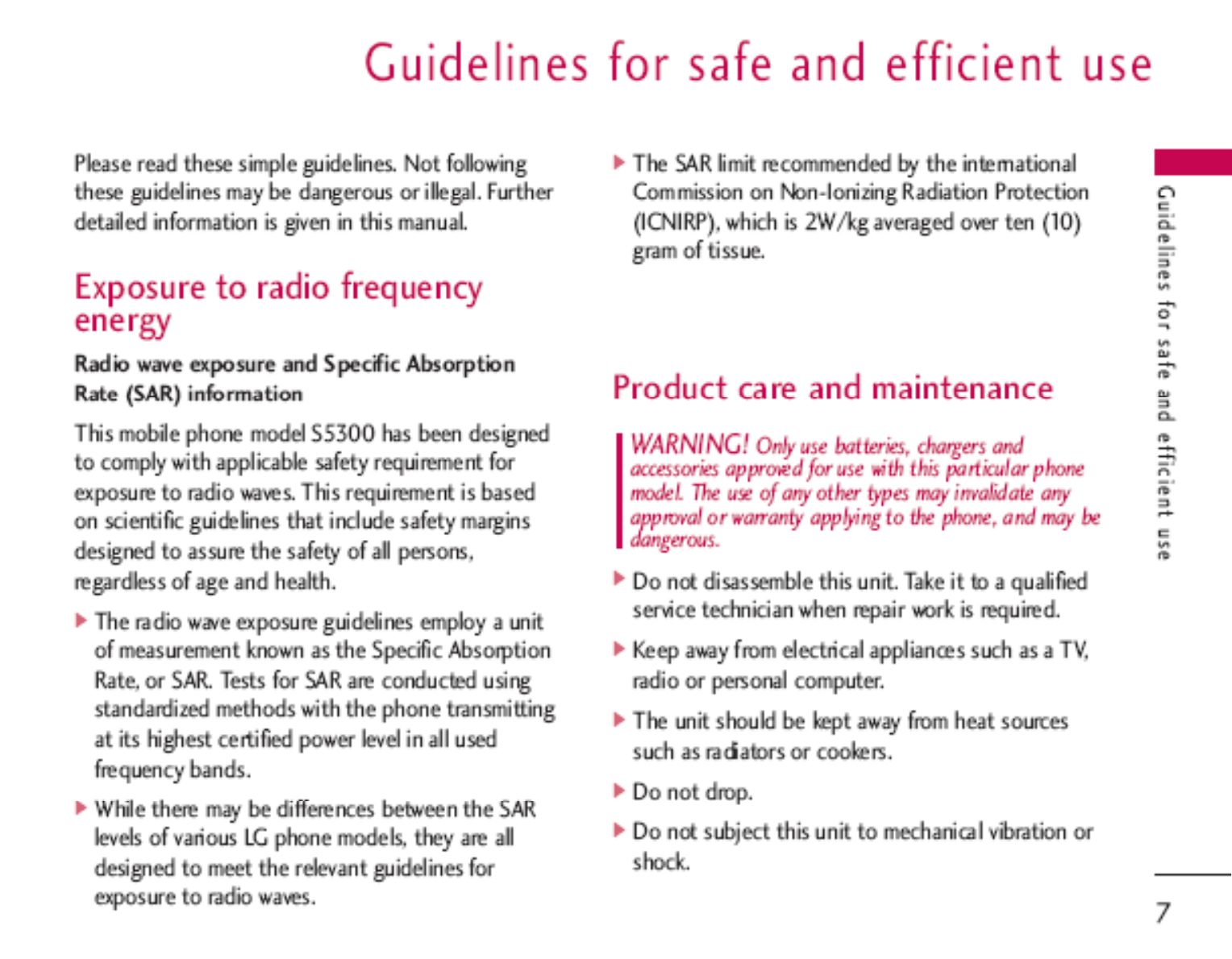

Guidelines for safe and efficient use
8
]The coating of the phone may be damaged if
covered with wrap or vinyl wrapper.
]Use dry cloth to clean the exterior of the unit.
(Do not use solvent such as benzene, thinner or
alcohol.)
]Do not subject this unit to excessive smoke or
dust.
]Do not keep the phone next to credit cards or
transport tickets; it can affect the information on
the magnetic strips.
]Do not tap the screen with a sharp object as it
may damage the phone.
]Do not expose the phone to liquid or moisture.
]Use the accessories like an earphone cautiously.
Electronics devices
All mobile phones may get interference, which could
affect performance.
]Do not use your mobile phone near medical
equipment without requesting permission. Avoid
placing the phone over pacemakers (i.e. in your
breast pocket.)
]Some hearing aids might be disturbed by mobile
phones.
]Minor interference may affect TVs, radios, PCs, etc.
Road safety
Check the laws and regulations on the use of mobile
phones in the areas when you drive.
]Do not use a hand-held phone while driving.
]Give full attention to driving.
]Use a hands-free kit, if available.
]Pull off the road and park before making or
answering a call if driving conditions so require.
Guidelines for safe and efficient use

9
]RF energy may affect some electronic systems in
your motor vehicle such as car stereo or safety
equipment.
]When your vehicle is equipped with an air bag, do
not obstruct with installed or portable wireless
equipment. It can cause serious injury due to
improper performance.
Blasting area
Do not use the phone where blasting is in progress.
Observe restrictions, and follow any regulations or
rules.
Potentially explosive
atmospheres
]Do not use the phone at a refueling point. Don’t
use near fuel or chemicals.
]Do not transport or store flammable gas, liquid, or
explosives in the compartment of your vehicle,
which contains your mobile phone and accessories.
In aircraft
Wireless devices can cause interference in aircraft.
]Turn off your mobile phone before boarding any
aircraft.
]Do not use it on the ground without crew
permission.
Children
Keep the phone in a safe place out of small children’s
reach. It includes small parts which if detached may
cause a choking hazard.
Emergency calls
Emergency calls may not be available under all
cellular networks. Therefore, you should never
depend solely on the phone for emergency calls.
Check with your local service provider.
Guidelines for safe and efficient use

Guidelines for safe and efficient use
10
Battery information and care
]You do not need to completely discharge the
battery before recharging. Unlike other battery
systems, there is no memory effect that could
compromise the battery’s performance.
]Use only LG batteries and chargers. LG chargers are
designed to maximize the battery life.
]
Do not disassemble or short-circuit the battery pack.
]Keep the metal contacts of the battery pack clean.
]Replace the battery when it no longer provides
acceptable performance. The battery pack may be
recharged hundreds of times until it needs
replacing.
]Recharge the battery if it has not been used for a
long time to maximize usability.
]Do not expose the battery charger to direct
sunlight or use it in high humidity, such as the
bathroom.
]Do not leave the battery in hot or cold places, this
may deteriorate the battery performance.
Guidelines for safe and efficient use
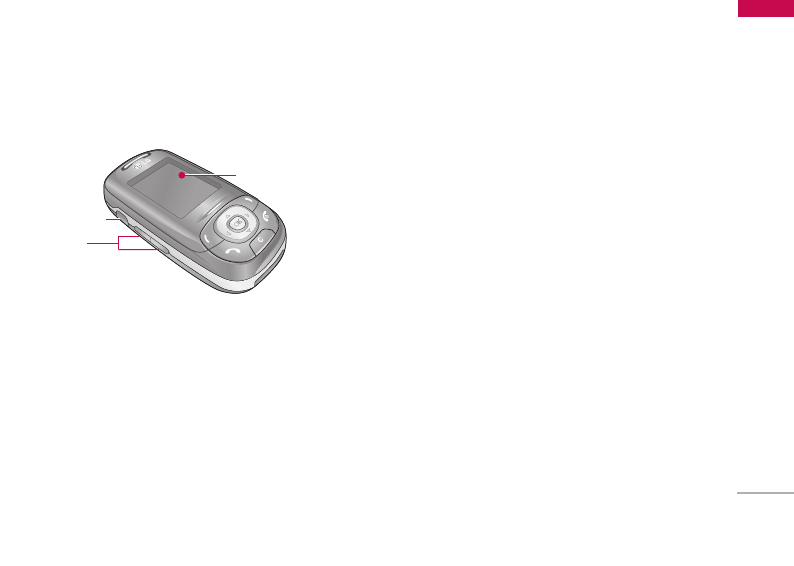
S5300 features
11
Parts of the phone
Front view
1. Headset jack
]Connect a headset here.
2. Up/down side keys
]Controls the volume of keypad tone in standby
mode with the phone open.
]Controls the earpiece volume during a phone
call.
3. Front screen
S5300 features
Up/down
side keys
Headset jack
Front screen
!
@
#
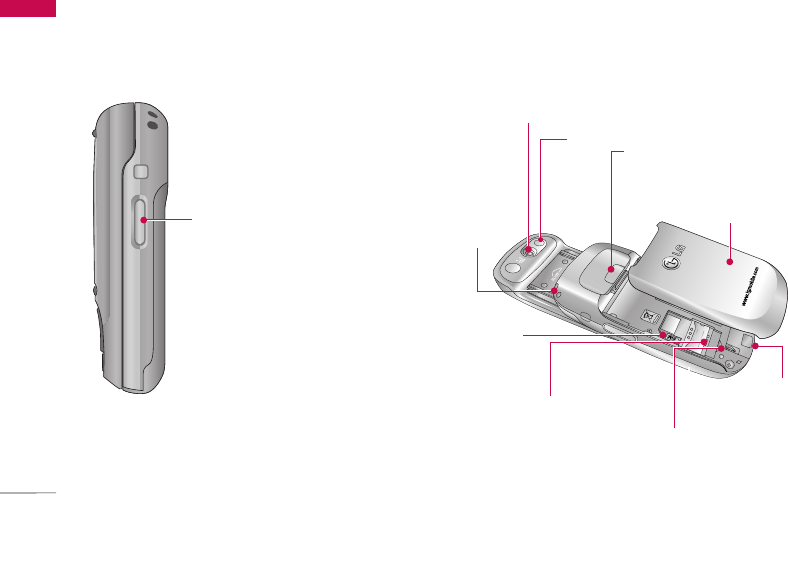
S5300 features
12
Right side view Rear view
S5300 features
Camera/MP3 key
]Open the slide to reveal the
camera lens. Press and hold down
this key to activate the camera
mode. Also use this key to take a
shot. Use the front screen as a
viewfinder.
Holes for a
carrying strap
SIM card
socket
Battery terminals
SIM card terminals
Battery latch
]Press this button to
remove the battery cover.
Camera lens
]Dirt on the camera lens
could affect the image quality.
Battery pack
Charger connector/
Cable connector
Flash
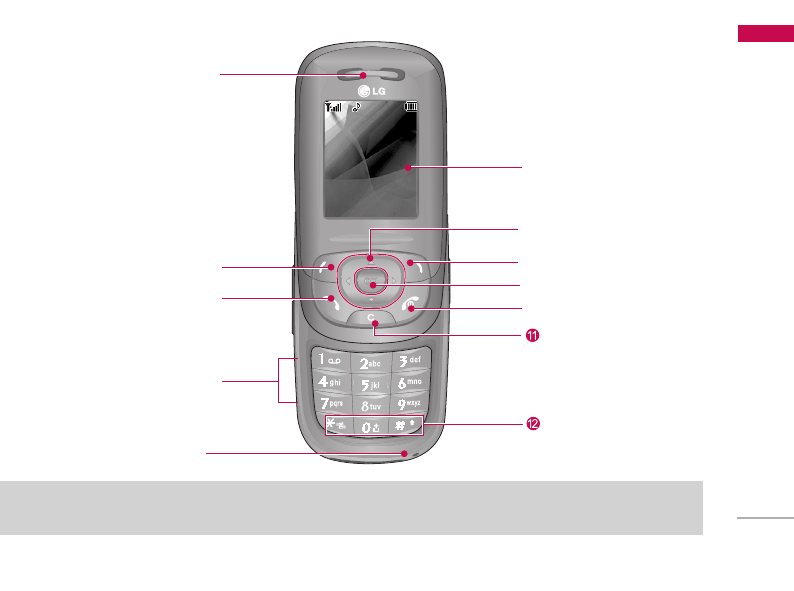
13
Open view
S5300 features
!
@
$
Menu Contacts
Earpiece
Left soft key
Send key
Alphanumeric keys
%
Microphone
Main screen
^
&
Navigation keys
Right soft key
*
(
Clear key
Special function keys
End/Power key
)
Confirm key
#
Note
]To prevent the difficulty in hearing of the other side, slide open while using phone.

1. Earpiece
2. Left soft key: Performs the function indicated by
the text on the screen immediately above it.
3. Send key: Dials a phone number and answers
incoming calls. You can also quickly access the
latest incoming, outgoing and missed calls by
pressing the key in standby mode.
4. Alphanumeric keys: Enter numbers, letters and
some special characters.
5. Microphone: Can be muted during a call for
privacy.
6. Main screen: Displays phone status icons, menu
items, Web information, pictures and more in full
colour.
7. Navigation keys: Use to scroll through menus and
move the cursor.
8. Right soft key: Performs the function indicated by
the text on the screen immediately above it.
9. Confirm key: Selects menu options and confirms
actions.
10. End/Power key: Used to end a call or reject a
call and also to go back to standby mode. Hold
this key down to turn the phone on/off.
11. Clear key: Deletes a character with each press.
Hold the key down to clear all input. Use this key
to go back to a previous screen.
12. Special function keys
]: A lon A long press of this key enters the
international call character “+”.
]: While While keying in a phone number,
a long press of this key enters a pause.
S5300 features
14
S5300 features
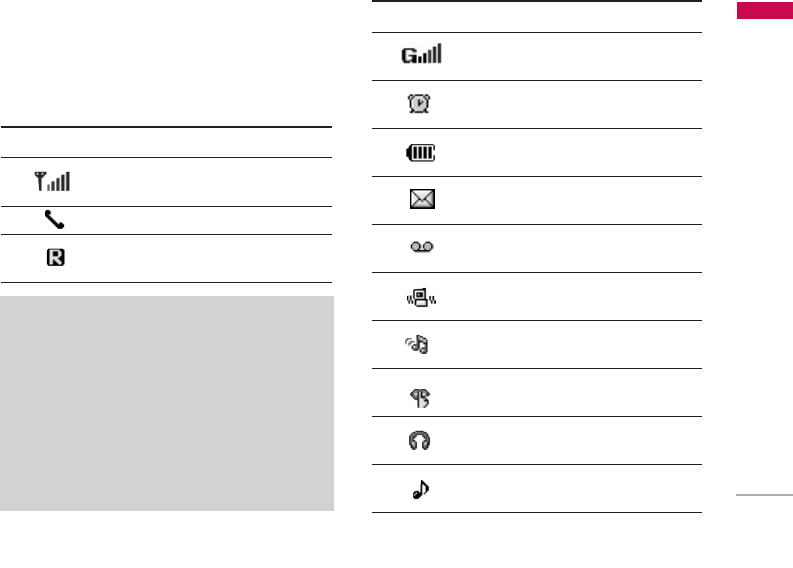
Display Information
The table below describes various display indicators
or icons that appear on the phone’s display screen.
On-Screen Icons
15
Icon Description
Indicates the strength of the
network signal. *
Indicates a call is in progress.
Indicates that you are roaming on
another network.
S5300 features
Icon Description
Indicates that GPRS service is
available.
Indicates the alarm has been set
and is on.
Indicates the status of the battery
charge.
Indicates the receipt of a
message.
Indicates the receipt of a voice
message.
Indicates that the vibration ringer
has been set.
Indicates the Loud profile is
activated.
Indicates the Silent profile is
activated.
Indicates the Headset profile is
activated.
Indicates the General profile is
activated.
Note
]*The quality of the conversation may change
depending on network coverage. When the signal
strength is below 2 bars, you may experience
muting, call drop and bad audio. Please take the
network bars as indicator for your calls. When
there are no bars, that means that there is no
network coverage: in this case, you won’t be able
to access the network for any service (call,
messages and so on).
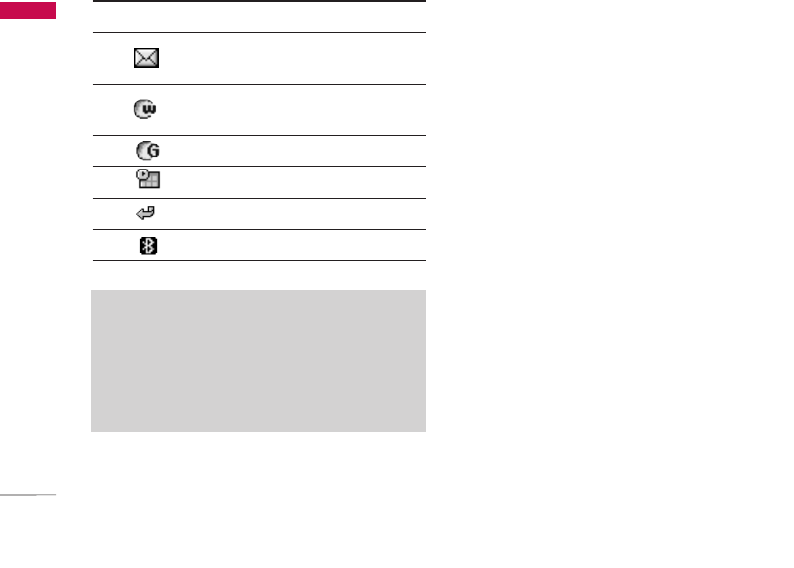
S5300 features
16
Icon Description
Indicates that you can use the
push message service.
Indicates that the phone is
accessing the WAP.
Indicates that you are using GPRS.
Agenda event set
Call divert service active
Bluetooth enabled
S5300 features
Note
]When the status of the battery indicates low,
you may not use Camera or Multimedia
function.
]While using Multimedia function, the status of
the battery is changeable.
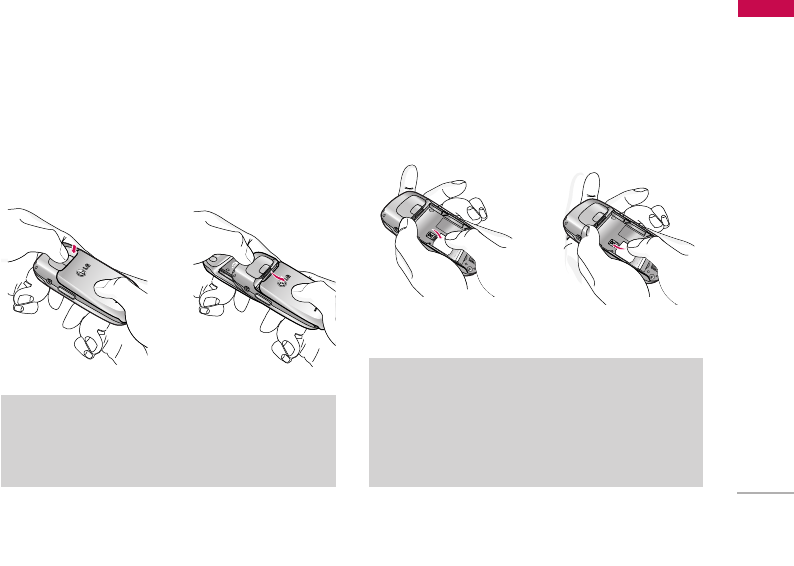
Getting started
17
Installing the SIM card and
battery
Make sure the power is off before you remove the
battery.
1. Remove the battery.
Press the button to release the battery, then slide
the battery down till it stops. Now lift the battery
from its compartment.
2. Install the SIM card.
Insert the SIM card into the holder. Slide the SIM
card into the SIM card holder. Make sure that the
SIM card is inserted properly and that the gold
contact area on the card is facing downwards. To
remove the SIM card, press down lightly and pull it
in the reverse direction.
Note
]Removing the battery from the phone when the
power is on may cause the phone to
malfunction.
Getting started
To insert the SIM card To remove the SIM card
Caution!
]The metal contact of the SIM card can be easily
damaged by scratches. Pay special attention to
the SIM card while handling.
Follow the instructions supplied with the SIM
card.
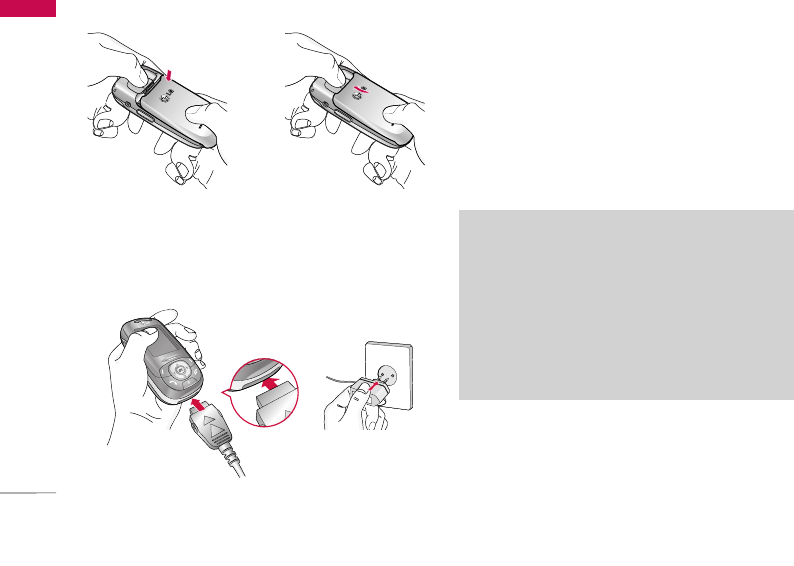
Getting started
18
3. Install the battery.
Charging the Battery
To connect the mains adapter to the phone, you
must have installed the battery.
1. With the arrow facing you as shown in the diagram
push the plug on the battery adapter into the
socket on the bottom of the phone until it clicks
into place.
2. Connect the other end of the mains adapter to
the mains socket. Only use the charger included in
the box.
3. The moving bars of battery icon will stop after
charging is complete.
Caution!
]Do not force the connector as this may damage
the phone and/or the charger.
]If you use the battery pack charger out of your
own country, use an attachment plug adapter
for the proper configuration.
]Do not remove your battery or the SIM card
while charging.
Getting started
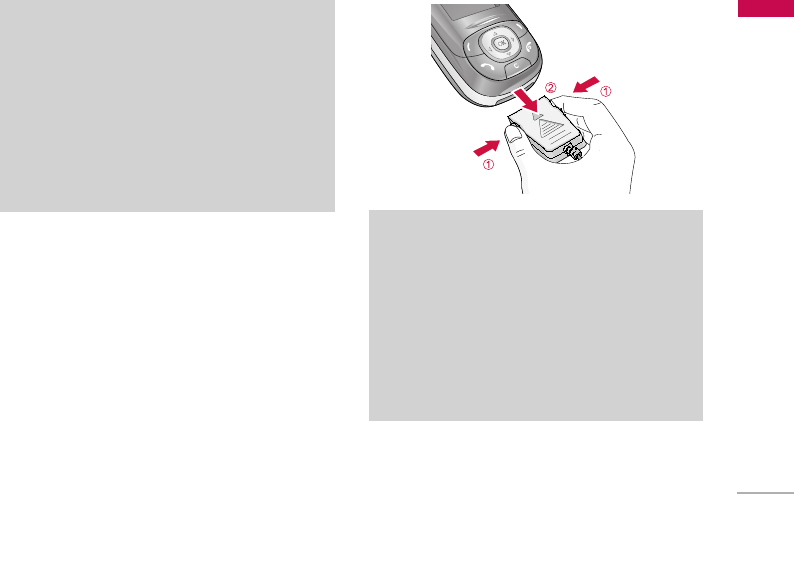
19
Disconnecting the adapter
Disconnect the travel adapter from the phone by
pressing its side buttons as shown in the diagram.
1. When charging is finished, the moving bars of the
battery icon stop and ‘Full’ is displayed on the
screen.
2. Unplug the adapter from the power outlet.
Disconnect the adapter from the phone by
pressing the grey tabs on both sides of the
connector and pull the connector out.
Warning!
]Unplug the power cord and charger during
lightning storms to avoid electric shock or fire.
]Make sure that no sharp-edged items such as
animal teeth or nails come into contact with the
battery. There is a risk of this causing a fire.
]Do not place or answer calls while charging the
phone as it may short-circuit the phone and/or
cause electric shock or fire.
Note
] Ensure the battery is fully charged before using
the phone for the first time.
] Do not remove the battery or SIM card while
charging.
] In the case the battery is not properly charged,
please turn the phone off and on using the
power key. Then detach and reattach the
battery, and recharge the phone.
Getting started

Getting started
20
Turning your phone on and off
Turning your phone ON
1. Install a battery to the handset and connect the
phone to an external power source such as the
travel adapter, cigarette lighter adapter or hands-
free car kit. Or install a charged battery pack to
the handset.
2. Press and hold for a few seconds until the
LCD screen is turned on.
3. Depending on the status of the PIN code request
setting you may need to enter your PIN code.
Turning your phone OFF
1. Press and hold for a few seconds until the
LCD screen is turned off.
Access codes
You can use the access codes described in this
section to avoid unauthorised use of your phone.
The access codes (except PUK and PUK2 codes) can
be changed by using the Change codes feature
[Menu 7-4-6].
PIN code (4 to 8 digits)
The PIN (Personal Identification Number) code
protects your SIM card against unauthorised use.
The PIN code is usually supplied with the SIM card.
When the PIN code request is set to Enable, your
phone will request the PIN code every time the
phone is switched on. When the PIN code request is
set to Disable, your phone connects to the network
directly without the PIN code.
PIN2 code (4 to 8 digits)
The PIN2 code, supplied with some SIM cards, is
required to access functions such as Advice of Call
Charge and Fixed dial number. These functions are
only available if supported by your SIM card. Check
with your network operator for further information.
Getting started

21
PUK code (4 to 8 digits)
The PUK (PIN Unblocking Key) code is required to
unlock a PIN blocked phone. The PUK code may be
supplied with the SIM card. If not, contact your
network operator for the code. If you lose the code,
also contact your network operator.
PUK2 code (4 to 8 digits)
The PUK2 code, supplied with some SIM cards, is
required to change a blocked PIN2 code. If you lose
the code, please contact your network operator.
Security code (4 to 8 digits)
The security code protects the unauthorised use of
your phone. The default security code is set to
‘0000’ and the security code is required to delete all
phone entries and to activate the Reset settings
menu. Also, the security code is required to enable or
disable the phone lock function to prevent
unauthorised use of the phone. The security code
default setting can be modified from the Security
settings menu.
Barring password
The barring password is required when you use the
Call barring function. You can obtain the password
from your network operator when you subscribe to
this function.
Getting started

General Functions
22
Making and answering calls
Making a call
1. Make sure your phone is switched on.
2. Enter a phone number, including the area code.
]Press and hold the clear key ( ) to erase
the entire number.
3. Press the send key ( ) to call the number.
4. To end the call, press the end key ( ) or the
right soft key.
Making a call from the call history list
1. In standby mode, press the send key ( ), and
the latest incoming, outgoing and
missed phone numbers will be displayed.
2. Select the desired number by using the up/down
navigation keys.
3. Press to call the number.
Making an international call
1. Press and hold the key for the international
prefix. The ‘+’ character automatically selects the
international access code.
2. Enter the country code, area code, and the phone
number.
3. Press to call the number.
Ending a call
When you have finished your call, press the end
() key.
Making a call from the phonebook
You can save the names and phone numbers dialled
regularly in Contacts. You can save them to the SIM
card and/or phone memory. You can dial a number
by simply looking up the desired name in the
phonebook and pressing the ( ) key.
General Functions
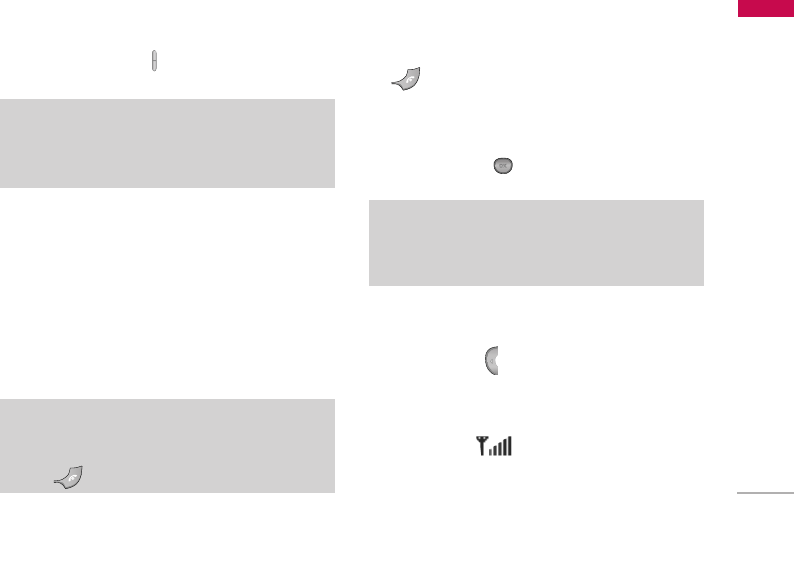
23
Adjusting the Volume
If you want to adjust the earpiece volume during a
call, use the side keys ( ) . Press the up side key to
increase and down side key to decrease the volume.
Answering a Call
When you receive a call, the phone rings and the
flashing phone icon appears on the screen. If the
caller can be identified, the caller’s phone number
(or name/photo if saved in the phonebook) is
displayed.
1. To answer an incoming call, open the phone.
(When Slide open has been set as the answer
mode. [Menu 7-3-2].)
]You can answer a call while using the address
book or other menu features.
2. To end the call, close the phone or press the
key.
Using the Speakerphone
You can use the integrated Speakerphone during a
call by pressing the key. The loudspeaker is
automatically deactivated when you end the call.
Manner mode (Quick)
You can activate the manner mode by pressing and
holding down the key after opening the phone.
Signal strength
You can check the strength of your signal by the
signal indicator ( ) on the LCD screen of your
phone. Signal strength can vary, particularly inside
buildings. Moving near to a window may improve
reception.
Note
]In standby mode with the phone open/closed,
pressing the side keys adjusts the key tone
volume.
Note
]If Press any key has been set as the answer
mode any key press will answer a call except for
the or the right soft key.
General Functions
Warning!
]Due to higher volume levels, don't place the
phone near your ear while the speakerphone is
enabled.

General Functions
24
Entering text
You can enter alphanumeric characters by using the
phone’s keypad. For example, storing names in the
phonebook, writing a message, creating a personal
greeting.
The following text input methods are available in the
phone.
T9 mode
This mode lets you enter words with only one
keystroke per letter. Each key on the keypad has more
than one letter. The T9 mode automatically compares
your keystrokes with an internal dictionary to
determine the correct word, thus requiring far fewer
keystrokes than the traditional ABC mode. This is
sometimes known as predictive text.
ABC mode
This mode lets you enter letters by pressing the key
labelled with the required letter once, twice, three or
four times until the letter is displayed.
123 mode (Number mode)
Type numbers using one keystroke per number. To
change to 123 mode in a text entry field, press the
key until 123 mode is displayed.
Changing the text input mode
1. When you are in a field that
allows characters to be
entered, you will notice the
text input mode indicator in
the top right corner of the
LCD screen.
2. Change the text input mode
by pressing . You can
check the current text input
mode in the top right corner
of the LCD screen.
Using the T9 mode
The T9 predictive text input mode lets you enter
words easily with a minimum number of key presses.
As you press each key, the phone begins to display
the characters that it thinks you are typing based on
the built-in dictionary.
General Functions
text input mode
Options Insert

25
You can also add new words in the dictionary. As new
words are added, the word changes to reflect the
most likely candidate from the dictionary. You can
turn the T9 mode on or off, and change the T9
language by holding down the ( ) key.
1. When you are in the T9 predictive text input
mode, start entering a word by pressing keys
to . Press one key per letter.
]The word changes as letters are typed. Ignore
what’s on the screen until the word is typed
completely.
]If the word is still incorrect after typing
completely, press the down navigation key once
or more to cycle through the other word
options.
Example: Press to type
Good.
Press [down
navigation key] to type Home.
]If the desired word is missing from the word
choice list, add it using the ABC mode.
]You can select the language of the T9 mode.
Press the left soft key [Option], then select T9
languages. Select the desired language of T9
mode. You can also turn off the T9 mode by
selecting T9 off. The default setting on the
phone is T9 enabled mode.
2. Enter the whole word before editing or deleting
any keystrokes.
3. Complete each word with a space by pressing the
key. To delete letters, press . Press and
hold down to erase entire words.
Using the ABC mode
Use the to keys to enter your text.
1. Press the key labelled with the required letter:
]Once for the first letter.
]Twice for the second letter.
]And so on.
Note
]To exit from the text input mode without saving
your input, press . The phone goes back
to standby mode.
General Functions
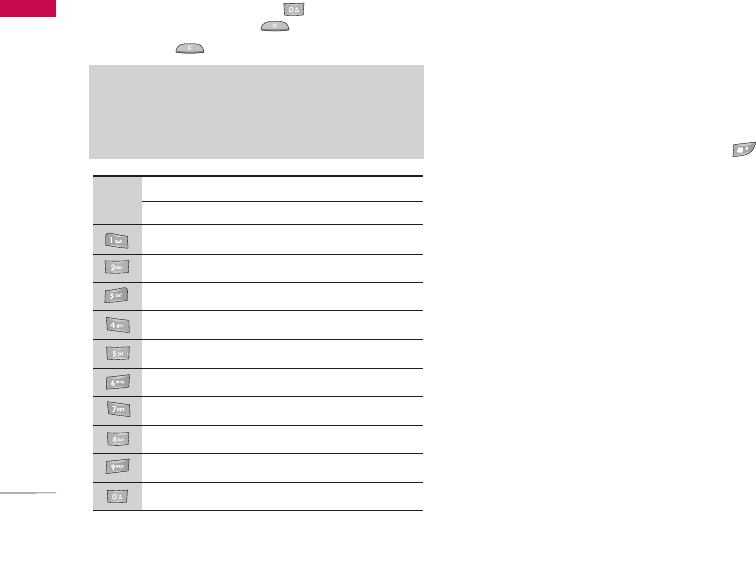
26
2. To insert a space, press the key once. To
delete letters, press the key. Press and hold
down the key to clear the whole display.
Using the 123 (Number) mode
The 123 mode enables you to enter numbers in a
text message (a telephone number, for example).
Press the keys corresponding to the required digits
before manually switching back to the appropriate text
entry mode. You can quickly switch from letters to
numbers by pressing and holding down the ( ) key.
Contacts
You can store phone numbers and their
corresponding names in the memory of your SIM
card.
In addition, you can store up to 1000 numbers and
names in the phone memory.
The SIM card and phone are both used in the same
way in the Contacts menu.
In-call menu
Your phone provides a number of control functions
that you can use during a call. To access these
functions during a call, press the left soft key
[Options].
Note
]Refer to the table below for more information
on the characters available using the
alphanumeric keys.
Key Upper Case Lower Case
. , / ? ! - : ' '' 1 . , / ? ! - : ' '' 1
A B C 2 a b c 2
D E F 3 d e f 3
G H I 4 g h i 4
J K L 5 j k l 5
M N O 6 m n o 6
P Q R S 7 p q r s 7
T U V 8 t u v 8
W X Y Z 9 w x y z 9
Space 0 Space 0
Characters in the order display
General Functions
General Functions

27
During a call
The menu displayed on the handset screen during a
call is different to the default main menu displayed
when in standby mode, and the options are
described below.
Making a second call
You can get a number you wish to dial from the
phonebook to make a second call. Press the right
soft key then select Search. To save the dialled
number into the phonebook during a call, press the
right soft key then select Add new.
Switching between two calls
To switch between two calls, press the left soft key
then select Swap.
Answering an incoming call
To answer an incoming call when the handset is
ringing, simply press the key. The handset is
also able to warn you of an incoming call while you
are already on a call. A tone sounds in the earpiece,
and the display will show that a second call is waiting.
This feature, known as Call waiting, is only available
if your network supports it. For details of how to
activate and deactivate it see Call waiting
[Menu 7-3-4].
If Call waiting is activated, you can put the first call
on hold and answer the second, by pressing or
by selecting the left soft key, then Hold & Answer.
You can end the current call and answer the waiting
call by selecting the left soft key and then End &
Answer.
Rejecting an incoming call
You can reject an incoming call without answering by
simply pressing the key.
During a call, you can reject an incoming call by
pressing the left soft key [Menu] key and selecting
the Conference/Reject or by pressing the .
Muting the microphone
You can mute the microphone during a call by
pressing the [Menu] key then selecting Mute on. The
handset can be unmuted by selecting
Mute off.
When the handset is muted, the caller cannot hear
you, but you can still hear them.
General Functions

General Functions
28
Switching DTMF tones on during a call
To turn DTMF tones on during a call, press the left
soft key, and then select DTMF on. DTMF tones can
be turned off the same way. DTMF tones allow your
phone to make use of an automated switchboard.
Multiparty or conference calls
The multiparty or conference service provides you
with the ability to have a simultaneous conversation
with more than one caller, if your network operator
supports this feature. A multiparty call can only be
set up when you have one active call and one call on
hold, both calls having been answered. Once a
multiparty call is set up, calls can be added,
disconnected or separated (that is, removed from the
multiparty call but still connected to you) by the
person who set up the multiparty call. These options
are all available from the In-Call menu. The maximum
callers in a multiparty call are five. Once started, you
are in control of the multiparty call, and only you can
add callers to the multiparty call.
Making a second call
You can make a second call while currently on a call.
Enter the second number and press the key.
When the second call is connected, the first call is
automatically placed on hold. You can swap between
calls by pressing the left soft key then selecting
Swap.
Setting up a conference call
Place one call on hold and while the active call is on,
press the left soft key and then select the
Conference/Join all.
Putting a conference call on hold
Press the left soft key, then select the
Conference/Hold all.
Activate the conference call on hold
Press the left soft key, then select the
Conference/Join all.
General Functions

29
Adding calls to the conference call
To add a call to an existing conference call, press the
left soft key, then select the Conference/Join all.
Displaying callers in a conference call
To scroll through the numbers of the callers who
make up a conference call on the handset screen, use
the up/down navigation keys.
Taking a private call during a
conference call
To have a private call with one caller from a
conference call, display the number of the caller you
wish to talk to on the screen, then press the left soft
key. Select the Conference/Private to put all the
other callers on hold.
Ending a conference call
The currently displayed caller from a conference call
can be disconnected by pressing the key. To
end a conference call, press the left soft key, then
select the Conference/End multiparty.
After pressing the left soft key, selecting
Conference/End all will end all the active and on-
hold calls.
General Functions
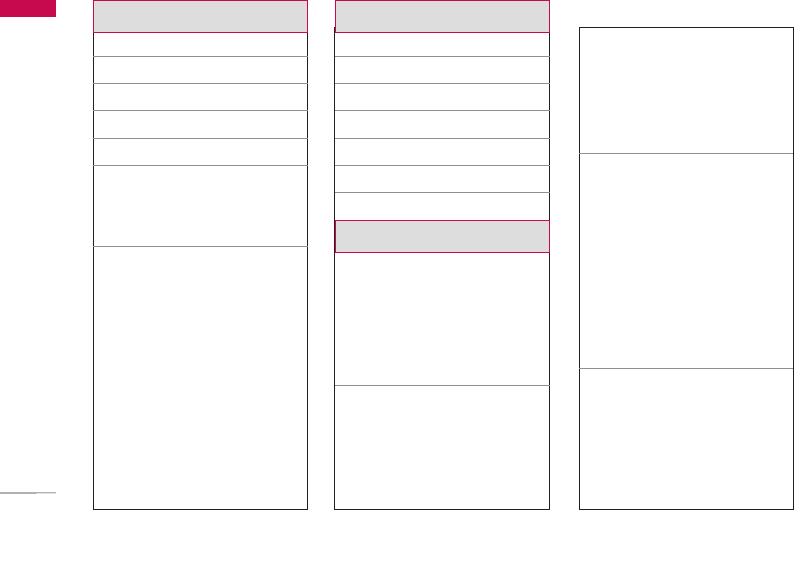
Menu Tree
30
1. Call register
1.1 Missed calls
1.2 Received calls
1.3 Dialled calls
1.4 All calls
1.5 Delete recent calls
1.6 Call charges
1.6.1 Call duration
1.6.2 Call costs
1.7 GPRS information
1.7.1 Call duration
1.7.2 Data volumes
2. Address book
2.1 Contact list
2.2 New contact
2.3 Caller groups
2.4 Speed dial
2.5 Own number
2.6 Business card
2.7 Settings
3. Settings
3.1 Date & Time
3.1.1 Set date
3.1.2 Date format
3.1.3 Set time
3.1.4 Time format
3.2 Phone settings
3.2.1 Display
3.2.1.1 Wallpaper
3.2.1.2 Handset scheme
3.2.1.3 Greeting note
3.2.1.4 Backlight timeout
3.2.1.5 Information
window
3.2.1 Languages
3.3 Call
3.3.1 Call forwarding
3.3.2 Answer mode
3.3.3 Send my number
3.3.4 Call waiting
3.3.5 Minute minder
3.3.6 Auto redial
3.3.7 Select line
3.4 Security settings
3.4.1 PIN Code request
3.4.2 Phone lock
3.4.3 Call barring
3.4.4 Fixed dial number
Menu Tree
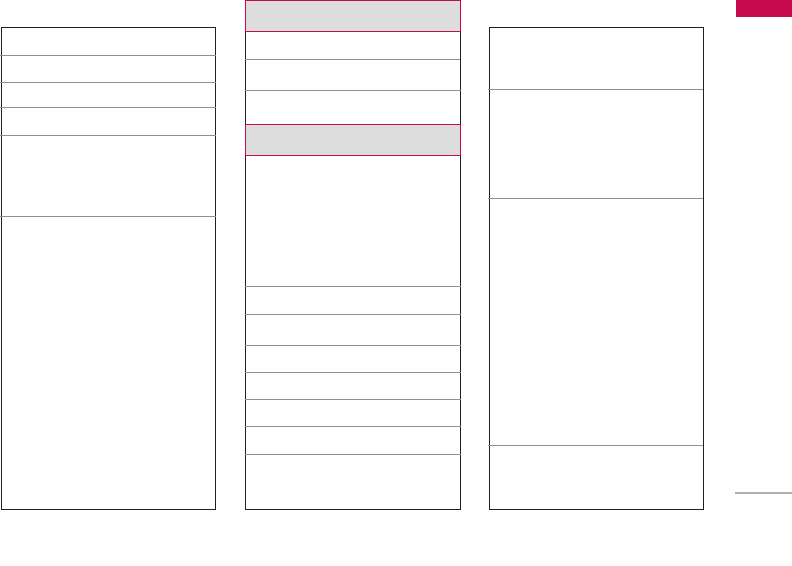
31
Menu Tree
3.4.5 Change codes
3.5 Network
3.6 GPRS attach
3.7 Reset settings
3.8 Memory status
3.8.1 Handset memory
3.8.2 Media memory
3.9 Aide Orange
3.9.1 Communiquer
3.9.2 Orange World
3.9.3 Jeux
3.9.4 Astuces
4. Camera
4.1 Take photo
4.2 Record video
4.3 Memory status
5. Messages
5.1 Create new massage
5.5.1 Text
5.5.2 Multimedia
5.5.3 Write email
message
5.2 Inbox
5.3 Orange Messenger
5.4 Drafts
5.5 Mailbox
5.6 Outbox
5.7 Listen to voice mail
5.8 Info message
5.8.1 Read
5.8.2 Topics
5.9 Templates
5.9.1 Text
5.9.2 Multimedia
5.9.3 Business card
5.0 Settings
5.0.1 Text messages
5.0.2 Multimedia
messages
5.0.3 Email
5.0.4 Voice mailbox
number
5.0.5 Info message
5.0.6 Download
messages
5.* Memory status
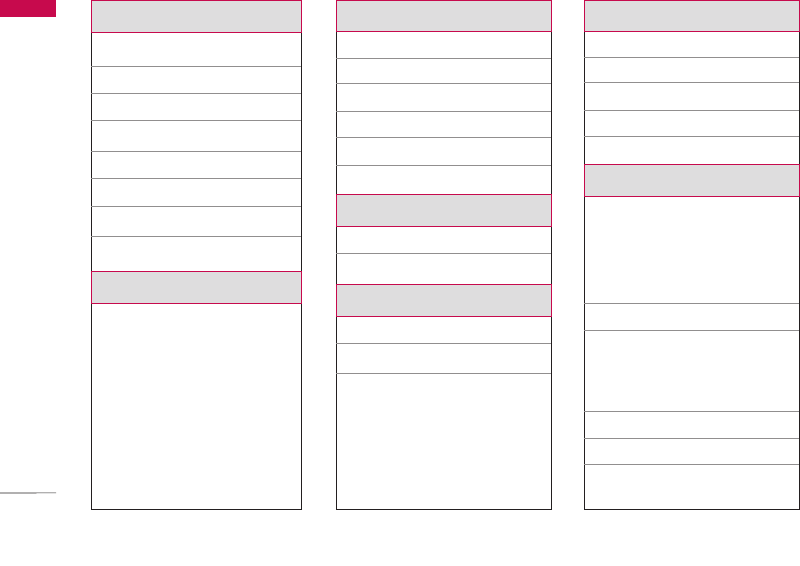
Menu Tree
32
Menu Tree
6. Orange World
6.1 Orange World
6.2 Mes Mails
6.3 Sonneries/Logos
6.4 Jeux
6.5 Cinema
6.6 Sports
6.7 Bookmarks
6.8 Settings
7. Music player
7.1 MP3 player
7.1.1 Playlist
7.1.2 Settings
8. My folder
8.1 Photo gallery
8.2 Video gallery
8.3 Music
8.4 Graphics
8.5 Ringtones / Audio
8.6 Games & Apps
9. Calendar
9.1 Scheduler
9.2 Memo
10. Games & Apps
10.1 Games & Apps
10.2 More games
10.3 Accounts
11. Profiles
11.1 Vibrate only
11.2 Quiet
11.3 General
11.4 Loud
11.5 Headset
12. Extras
12.1 Bluetooth
12.1.1 My devices
12.1.2 Handsfree devices
12.1.3 Settings
12.2 Alarm clock
12.3 Voice recorder
12.3.1 Record
12.3.2 View list
12.4 Calculator
12.5 World time
12.6 Unit converter
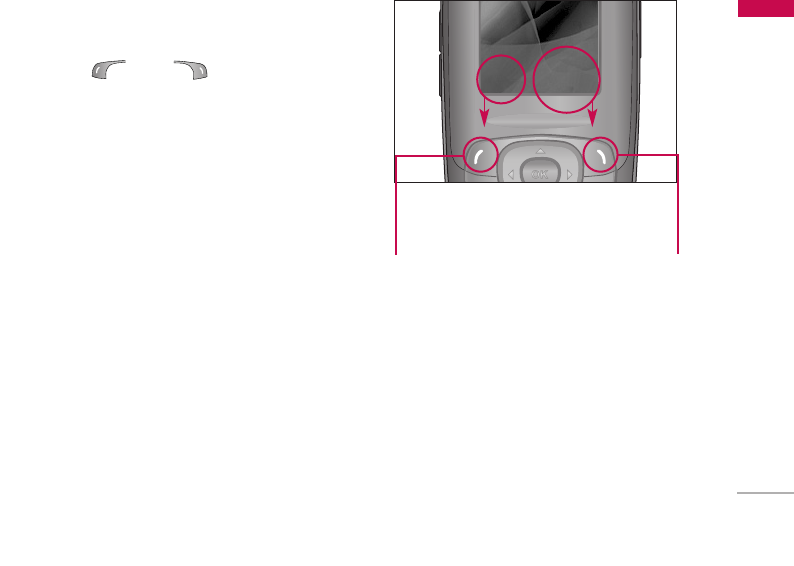
Selecting Functions and Options
33
Selecting Functions and Options
Your phone offers a set of functions that allow you to
customise the phone. These functions are arranged in
the menus and sub-menus, accessed via the two soft
keys marked [ ] and [ ]. Each menu and
sub-menu lets you view and alter the settings of a
particular function.
The role of the soft keys vary according to the
current context or the label on the bottom line of the
screen just above each key indicates its current role.
Press the left soft key
to access the available
menu.
Press the right soft
key to access the
available Contacts.
Menu Contacts

Call register
34
You can check the record of missed, received, and
dialled calls only if the network supports the Calling
Line Identification (CLI) within the service area.
The number and name (if available) are displayed
together with the date and time at which the call was
made. You can also view call times.
Missed calls Menu 1.1
This option lets you view the last 10 unanswered
calls. You can also:
]View the number if available and call it, or save it in
the Address Book.
]Enter a new name for the number and save both in
the Address Book.
Received calls Menu 1.2
This option lets you view the last 10 incoming calls.
You can also.
Dialled calls Menu 1.3
This option lets you view the last 20 outgoing calls
(called or attempted). You can also.
All calls Menu 1.4
You can view all lists of outgoing or incoming calls.
Delete recent calls Menu 1.5
Allows you to delete Missed calls and Received calls
lists. You can delete Dialled calls and All calls lists at
one time.
Call charges Menu 1.6
Call duration (Menu 1.6.1)
Allows you to view the duration of your incoming and
outgoing calls. You can also reset the call times. The
following timers are available:
] Last call: Length of the last call.
] All calls: Total length of all calls made and
incoming calls since the timer was last reset.
Call register

35
] Received calls: Length of the incoming calls.
] Dialled calls: Length of the outgoing calls.
] Reset all: Allows you to reset the timers of all calls
by pressing the left soft key [Yes ].
Call costs (Menu 1.6.2)
Allows you to check the cost of your last call, all calls,
remaining and reset the cost. To reset the cost, you
need to know your PIN2 code.
GPRS information Menu 1.7
You can check the amount of data transferred over
the network through the GPRS information option. In
addition, you can also view how much time you are
online.
Call duration (Menu 1.7.1)
You can check the duration of Last call and All calls.
You can also reset the call timers.
Data volumes (Menu 1.7.2)
You can check the Sent(Last/All), Received(Last/All)
or All data volumes and
Reset all
.
Call register

Address book
36
You can store phone numbers and their
corresponding names in the memory of your SIM
card. In addition, you can store up to 250 numbers
and names in the phone memory. The SIM card and
phone memories, although physically separate, are
used as if they were a single entity, called the
Contact.
Contact list Menu 2.1
1. In menu mode, select Contact >Contact List.
2. Press the left soft key [Select].
3. If you want to edit, delete, copy an entry, or to
add the voice to one, select [Options].
4. Once you have found the required entry, press the
to dial the number.
]View detail: To view in detail the selected name.
]Delete: You can delete an entry.
]Write messages: You can write a short message
and a multimedia message. For further details, see
page 67.
]Edit: You can edit the name, mobile number, home
number, office number, E-mail, group, picture by
press the left soft key [Select].
]Copy to handset: You can copy an entry from SIM
to phone.
]Assign speed dial: You can call directly to set
speed dials in this opton. For further details, see
page 96.
]View caller groups: For further details, see page
97.
Address book
Note
]You can also scroll through the Contact from
the beginning, in idle mode with slide open, by
pressing the down navigation key directly.
Note
]When a contact with several numbers is copied
from the phone memory to the SIM memory,
only the number entered as the main number
will be copied.

37
New contact Menu 2.2
You can add a address book entry by using this
function. Phone memory capacity is 250 entries. SIM
card memory capacity depends on the cellular
service provider. You can also save 40 characters of
name in the phone memory, and save characters in
the SIM card. The number of characters is dependent
on the SIM.
1. In menu mode, select Contact >New.
2. You can add new contact entries to the SIM
memory or the phone memory. To select the
memory, go to Set memory [Menu-8-7-1].
]Adding new entries into SIM memory: You can
enter a name and number, and select the required
group. (Depends on the SIM).
]Adding new entries into handset memory: You
can enter a name, numbers, E-mail address and
memo, and select the required group.
Caller groups Menu 2.3
There are 7 predefined groups as well as one
additional group labeled Others where you can
create your own lists.
1. Every Group list will be displayed: Family,
Friends, Colleague, VIP, Group 1, Group 2,
Group 3.
2. Select the Group name that you want to manage
by pressing the left soft key [Options].
]Member list: Allows you to see the member list in
the group.
]Group ringtone: Allows you to select the ring tone
to be used when you receive a voice phone call
from a person in the group.
]Group icon: Allows you to select the graphic icon
to be displayed when you receive a call from a
person in the group.
]Add member: Allows you to add the member to
the group.
]Remove member: Allows you to delete the
member in the group.
Address book

Address book
38
]Rename: Allows you to assign a name to the
group.
]Remove all: Allows you to delete all the member in
the group.
Speed dial Menu 2.4
You can assign any of the keys, to with a
name list entry.
You can call directly by pressing this key for 2-3
seconds.
1. In menu mode, select Contact >Speed dial list
Or, in standby mode, hold down in the
standby mode.
2. If you want to add a number to speed dial, select
<Empty>. Then, you can search the name from the
Address Book.
3. Select the name from the speed dial. You can
change and delete the name. In addition, you can
call by this number, write text message, and
multimedia message.
Own number Menu 2.5
You can save and check your own number in SIM
card.
Business card Menu 2.6
This option allows you to create your own business
card featuring Name and an mobile phone number.
To create a new business card, press the left soft key
[Edit] and enter the information into the fields.
Settings Menu 2.7
1. Press the right soft [Contacts] in standby
mode.
2. Scroll to Settings, then press the left soft key
[Select].
]Default memory
Scroll to highlight Default memory, and then
press the left soft key [Select].
- If you select Always ask, when adding entry, the
phone will ask where to store.
Address book

39
- If you select SIM or Phone, the phone will store
an entry to SIM or phone.
]View options
Scroll to highlight View options, and then press
the left soft key [Select].
- Name only: Set the phonebook list with
displaying only name.
- Name & number: Set the phonebook list with
displaying name and number.
- With pictures: Set the phonebook list with the
information of character and picture.
]Copy/Move all
You can copy/move entries from SIM card memory
to Phone memory and vice versa.
1. Open the Phonebook first by pressing the right
soft key [Contacts] in standby mode.
2. Scroll to Copy/Move all, and then press the left
soft key [Select] to enter this menu.
• SIM to Phone: You can copy the entry from SIM
Card to Phone memory.
• Phone to SIM: You can copy the entry from
Phone memory to SIM Card.
]Memory in use: This feature allows you to see how
many free and in-use are in your phonebook.
]Clear contacts
You can delete all entries in SIM and Phone. This
function requires Security code.
1. Press the right soft key [Contacts] in
standby mode and select Delete all, press
[Select].
2. Then select a memory to erase.
3. Enter security code and Press the left soft key
[OK] or the right soft key [Back].
]Service dial number
Use this function to access a particular list of
services provided by your network operator (if
supported by the SIM card).
Address book

Settings
40
Date & Time Menu 3.1
You can set functions relating to the date and time.
Set date (Menu 3.1.1)
You can enter the current date.
Date format (Menu 3.1.2)
You can set the Date format such as YYYY/MM/DD,
DD/MM/YYYY, MM/DD/YYYY. (D: Day / M: Month
/ Y: Year).
Set time (Menu 3.1.3)
You can enter the current time.
Time format (Menu 3.1.4)
Your can set the time format between 24-hour and
12-hour.
Phone settings Menu 3.2
Display (Menu 3.2.1)
Wallpaper (Menu 3.2.1.1)
You can select the background pictures in standby
mode. There are 2 folders that include graphics and
pictures originated from built-in camera or web sites.
No Wallpaper make the background be white.
Handset scheme (Menu 3.2.1.2)
You can choose 4 kinds of color schemes, Metalic
style, Clean style, Clear style and Paper style.
Greeting note (Menu 3.2.1.3)
If you select On, you can edit the text which is
displayed in standby mode.
Settings
Note
]If Info messages are enabled on Channel 50, the
standby text is shown alternatively with the
location name. See [Menu 5-8] for more
information about Info messages.

41
Backlight timeout (Menu 3.2.1.4)
You can set the light-up duration of the internal
display. There are 3 lightup durations, 10, 20, 30
seconds.
Information window (Menu 3.2.1.5)
You can preview the current state of the selected
menu before open the menu. The state is shown at
bottom of the display.
Languages (Menu 3.2.2)
You can change the language for the display texts in
your phone. This change will also affect the Language
Input mode. S5300 supports English, French,
Spanish.
Call Menu 3.3
To change the settings for call diverting:
Call forwarding (Menu 3.3.1)
When this network service is activated, you can direct
your incoming calls to another number, for example,
to your voice mailbox number. For details, contact
your service provider. Select one of the divert
options, for example, select If busy to divert voice
calls when your number is busy or when you reject
incoming calls.
]All voice calls: Diverts voice calls unconditionally.
]If busy: Diverts voice calls when the phone is in
use.
]If no reply: Diverts voice calls which you do not
answer.
]If out of reach: Diverts voice calls when the phone
is switched off or out of coverage.
]All data calls: Diverts to a number with a PC
connection unconditionally.
]All fax calls: Diverts to a number with a fax
connection unconditionally.
The following menu corresponds to each option:
• Activate: Activates the corresponding service.
- To other number: Inputs the number for
diverting.
- To favourite number: You can check recent five
diverted numbers.
Settings

Settings
42
• Cancel: Cancels the corresponding service.
• View status: Checks the status of the service.
]Cancel All: Cancels all call divert service.
Answer mode (Menu 3.3.2)
Allows you to determine when to answer the phone.
]Slide open: When the phone rings, you can answer
a call simply by sliding up the keypad.
]Any key: You can answer an incoming call by
pressing any key, except the key.
]Send only: You can answer an incoming call by
only pressing the key.
Send my number (Menu 3.3.3)
This network service allows you to set your phone
number to be displayed On or hidden Off from the
person to whom you are calling. Select Set by
network to reset the phone to the setting that you
have agreed upon with your service provider.
Call waiting (Menu 3.3.4)
The network will notify you of a new incoming call
while you have a call in progress. Select Activate to
request the network to activate call waiting, Cancel to
request the network to deactivate call waiting, or
View status, to check if the function is active or not.
Minute minder (Menu 3.3.5)
This option allows you to specify whether the phone
must beep every minute during an outgoing call to
keep you informed of the length of the call.
Auto redial (Menu 3.3.6)
Select On, and your phone will make a maximum of
three attempts to connect the call after an
unsuccessful call attempt.
Select line (Menu 3.3.7)
You can send the DTMF (dual tone multi-frequency)
tones of the number on the display during a call.
This option is helpful for entering a password or
account number when you call an automated system,
like a banking service.
Settings

43
Security settings Menu 3.4
Various codes and passwords are used to protect the
features of your phone. They are described in the
following sections (see pages 24).
PIN Code request (Menu 3.4.1)
When the PIN code request feature is enabled, you
must enter your PIN each time you switch the phone
on. Consequently, any person who does not have
your PIN cannot use your phone without your
approval.
The following options are available:
]Enable: You must enter the PIN each time the
phone is switched on.
]Disable: The phone connects directly to the
network when you switch it on.
Phone lock (Menu 3.4.2)
You can use security code to avoid unauthorized use
of the phone. If you set phone lock to When SIM
Changed, your phone will request security code only
when you change your SIM card. If you want to lock
your phone after power on, set Phone Lock to
Immediately.
]When switch on
- Off: No security code needs to be entered when
switching on the phone.
- Always on: The security code is requested
whenever the phone is switched on.
Settings
Note
]Before disabling the PIN code request feature,
you must enter your PIN.
Warning
]If you enter the wrong PIN code more than
three times on switching on the phone, the SIM
card blocks itself. If the PIN is blocked you must
enter the PUK code. The PUK code can be
entered up to 10 times. If you enter the wrong
PUK code more than 10 times, it will be
impossible to unblock the SIM card. In this case
contact your network operator.

Settings
44
- When SIM changed: The security code is only
requested if the SIM card is changed.
]Immediately
After entering the correct security code, the
telephone becomes inactive and locks. If you wish
to disable the telephone lock feature, the correct
security code must be entered after pressing the
right ‘Unlock’ key. If your telephone is locked when
switched off, it will still be locked when switched
back on.
Call barring (Menu 3.4.3)
Call barring allows you to restrict from making and
receiving calls with your phone. For this function, you
need the barring password, which you can obtain
from your service provider.
The following options are available:
]All outgoing calls: Calls cannot be made.
]Outgoing international: International calls cannot
be made.
]O/G (Outgoing) international except home
country: When abroad, calls can be made only to
numbers within the current country and to your
home country, which is where your home network
provider is located.
]All incoming: Calls cannot be received.
]Incoming when abroad: Calls cannot be received
when you are using your phone outside your home
service area.
]Cancel all: All call barring settings are deactivated;
calls can be made and received normally.
]Change password: You can set and change the
call barring password obtained from your service
provider using this option. You must enter the
current password before you can specify a new
one. Once you have entered a new password, you
are asked to confirm it by entering it again.
Settings
Note
]To use Call Barring service, you must input the
network password. When calls are barred, calls
may be possible to certain emergency numbers
in some networks.

45
Fixed dial number (Menu 3.4.4)
Allows you to restrict your outgoing calls to selected
phone numbers, if this function is supported by your
SIM card. The PIN2 code is required.
The following options are available:
]Enable: You can only call phone numbers stored in
the Contact. You must enter your PIN2.
]Disable: You can call any number.
]Number List: You can view the number list saved
as fixed dial number.
Change codes (Menu 3.4.5)
The Change codes feature allows you to change your
current password to a new one. You must enter the
current password before you can specify a new one.
You can change the access codes: Security code,
PIN1 Code, PIN2 Code.
Network Menu 3.5
You can select a network which will be registered
either automatically or manually. Usually, the network
selection is set to Automatic.
]Automatic
If you select Automatic mode, the phone will
automatically search for and select a network for
you. Once you have selected “Automatic”, the
phone will be set to “Automatic” even though the
power is off and on.
]Manual
The phone will find the list of available networks
and show you them. Then you can select the
Settings
Note
]Not all SIM cards have a PIN2. If your SIM card
does not, this menu option is not displayed.
Note
]PIN: Personal Identification Number.
Note
]A different network other than the local network
can only be selected if the roaming contract
with the national network provider offers said
service.

Settings
46
network which you want to use if this network has
a roaming agreement with your home network
operator. The phone let you select another
network if the phone fails to access the selected
network.
]Preferred
You can set a list of preferred networks and the
phone attempts to register with first, before
attempting to register to any other networks. This
list is set from the phone’s predefined list of known
networks.
GPRS attach Menu 3.6
If you select Switch on and you are in a network that
supports packet data, the phone registers to the
GPRS network and sending short messages will be
done via GPRS. Also, starting an active packet data
connection, for example, to send and receive e-mail,
is quicker. If you select When Needed, the phone will
use a packet data connection only if you start an
application or action that needs it. The GPRS
connection is closed after it is not used by any
application.
Reset settings Menu 3.7
You can easily reset your phone to its default
configuration. To do so, proceed, as follows.
1. Select the Reset Settings menu option.
2. Enter the 4-digit phone password.
Memory status Menu 3.8
Handset memory (Menu 3.8.1)
]This function shows the status of the user memory
of the handset.
Settings
Note
]If there is no GPRS coverage and you have
chosen Switch on, the phone will periodically
try to establish a packet data connection.
Note
]The password is preset to 0000.

47
Media memory (Menu 3.8.2)
]This function shows the status of the multimedia
memory of the handset.
Aide Orange Menu 3.9
Communiquer (Menu 3.9.1)
Orange World (Menu 3.9.2)
Jeux (Menu 3.9.3)
Astuces (Menu 3.9.4)
Settings

Camera
48
The S5300 phone features a built-in digital camera
which allows you to take photos with a maximum
resolution of 640x480 pixel (also called VGA). The
CMOS sensor also lets you take high quality
photographs thanks to extra features such as digital
zoom up to 4x (depending on resolution), light
control, white balance, change of colour, etc. Lastly
the built-in flash also lets you take photographs in
poor lighting conditions. The camera lets you take
photos at any time, capturing charming images to be
sent via MMS. You can also record videos to
immortalise the funniest situations and have them
with you at all times.
The camera is fitted to the top part of the phone and
can be turned around by 180°. This allows you to
easily focus on objects in front of you or behind the
telephone.
Take photo Menu 4.1
Press the Menu key and select Camera. Take
picture. Or, press the camera hot key in standby
mode. You can see the viewfinder. Before taking a
shot, press the right soft key [options] to set the
following values. Select the desired value and press
the OK key to confirm it.
]Resolution: Allows you to set the image size to
one of Hi (640
x
480), Med (320
x
240) and Low
(128
x
160).
]Quality: Allows you to set the image quality from
Economy, Normal and High.
]White Balance: 5 settings are available: Auto,
Daylight, Incandescent, Cloudy, and Fluorescent.
]Self Timer: Allows you to select the delay time
(off, 3 Seconds and 10 Seconds). Then the phone
takes a photo after the specified time.
Camera
Note
]In Take photo mode, You can change the
capture mode to press the left soft key [Video].
Note
]The Photo Camera feature cannot be used if the
battery is almost flat.

49
]Flash: Allow you to set the flash when you you take
a photo in dark place.
]Reverse view: Allows you to reverse the image
vertically.
]Colour effect: 3 settings are available: Color,
Sepia, Mono.
]Fun frames: Allows you to use a fun frame from the
list.
]Multishot: Allows you to take photos in
succession.
]Shutter tones: Allows you to change the Shutter
tones from Sound1, Sound2 and Sound3.
]Default settings: Set to default setting.
Taking a photo
After selecting the settings you want on the camera,
focus on the subject you wish to take and press the
Camera or OK key to take the photo. The photo will
be automatically saved in the Photo Album. The
photo can be sent via MMS by pressing the left soft
key [Send] while the following menu is accessed by
pressing the right soft key [Options]:
- Delete: Deletes the photo just taken.
- Set as wallpaper: Uses the photo taken as the
phone's wallpaper.
- Set as photo ID: Allows you to link the photo to a
contact in the address book in order to use the
photo address book feature. When you receive a
call from the contact in question, his/her photo will
appear on the display screen.
When a photo with a higher resolution than
128
x
160 pixel is linked, the photo can be trimmed
by pressing the right soft key Zoom. The left soft
key " + " enlarges the photo, the right soft key " - "
reduces it and you can choose the area to be
trimmed using the arrow keys.
Camera
Note
]Zoom and Lighting can be adjusted using the
navigation keys.

Camera
50
- Photo gallery: Accesses Album where all photos are
stored.
- Rename: Changes the name of the photo taken.
Taking multiple shots in succession
Set the camera, select Multishot mode and the
number of shots you want (1, 3 or 6). Focus on the
subject you wish to take and press the Camera key.
The phone will shoot all the photos with an interval
of less than 0.5 seconds between each shot. All the
photos taken will be automatically saved in the Photo
gallery.
Record video Menu 4.2
You can record the video up to 60 minutes. But it
depends on the resolution, the available memory
capacity, and the quantity of data to be compressed.
Press Record video You can record a video clip in
this menu by pressing the Camera key. Before taking
a shot, press the right soft key [options] to set the
following values. Select the desired value and press
the OK key to confirm it.
]Recording mode
- General: Allows you to record the video as much
time as you want.
- MMS video: Allows you to record the video clip
for sending via MMS.
* When you select MMS video mode, the Icon
appears on the bottom line. The maximum
capacity of MMS video is 100kb at once.
]Resolution: Allows you to set the image size from
Low (128
x
96) and Hi (176
x
144).
]Quality: Allows you to set the image quality from
Economy, Normal and High.
]White Balance: 5 settings are available: Auto,
Daylight, Incandescent, Cloudy, and Fluorescent.
]Flash: Allow you to set the flash when you you take
a photo in dark place.
Camera
Note
]In Record video mode, You can change the
capture mode to press the left soft key [Photo].

51
]Reverse view: Allows you to reverse the image
vertically.
]Colour effect: 3 settings are available: Color,
Sepia, Mono.
]Default settings: Set to default setting.
Press the Camera key to start recording a video clip.
REC time is updated on the LCD screen.
To stop recording, press the Camera key again. It is
automatically saved in Video gallery. And you can
keep recording another video clip by pressing the
Camera key.
Memory status Menu 4.3
Press the Menu key and select Camera, Memory
status. You can check the current memory status on
the phone. Images and Video share the memory.
Camera

Messages
52
Create new massage Menu 5.1
S5300 telephones allow you to write short text
messages which can be linked to create messages
containing up to approx. 1530 characters (a standard
text message contains a maximum of 160 characters),
corresponding to 10 pages. EMS (Enhanced
Messaging Service) can also be used to attach icons,
sounds and simple animation to the message. In
particular this telephone model supports EMS 5.0
which allows you to send and receive colour graphics
and to customise the text message layout and font. If
the message recipient’s phone does not support this
version, he/she will receive the compatible features
only and receipt of the written message is normally
guaranteed.
The length of an enhanced or long message can be
checked while writing using the indicators found to
the top left of the screen. The first number refers to
the number of characters left to complete the
individual text message while the second shows the
number of messages written. The cost of a long
message depends on the number of short text
messages linked together. All the available options for
writing short messages are shown below.
Text (Menu 5.1.1)
You can write and edit text message, checking the
number of message pages.
1. Enter the Messages menu by pressing the left soft
key [Select].
2. If you want to write a new message, select Create
new message.
3. To make text input easier, use T9.
4. Press [Insert] to attach the followings.
5. If you want to set option for your text, or to finish
your writing, press the left soft key [Options].
Insert
]Symbol: You can add special characters.
Messages
Note
]The phone which supports EMS release 5 is
available to send colour pictures, sounds, text
styles, etc. The other party may not receive
pictures, sounds or text styles you sent properly
if the phone does not support such options.

53
]Graphic: You can insert the Default graphics or
graphics in My pictures that are available for short
messages.
]Sound: You can insert sounds that are available for
short messages.
]Text templates: You can use Text templates
already set in the phone.
]Phonebook: You can add phone numbers or e-
mail addresses in address book.
]Business card: You can add your Business card to
the message.
Options
]Send To: Sends text messages.
1. Enter numbers of recipient.
2. Press key to add more recipients.
3. You can add phone numbers in the address
book.
4. Press the left soft key after entering numbers.
]Save to drafts: Stores messages in Drafts.
]Font: You can select Size and Style of fonts.
]Colour: You can select Colour of foreground and
background.
]Alignment: You can make the message contents
aligned Left, Center or Right.
]Add T9 dictionary: You can add your own word.
This menu can be shown only when edit mode is
Predictive (T9Abc/T9abc/T9ABC).
]T9 language: Select a T9 input mode.
]Exit: If you press Exit while writing a message, you
can end the writing message and back to the
Message menu. The message you have written is
not saved.
Multimedia (Menu 5.1.2)
A multimedia message may contain text, pictures and
sounds. This feature can only be used if supported
by your network operator or service provider. Only
handsets offering features that are compatible with
multimedia messaging or emails can receive and send
multimedia messages. Multimedia messages can be
formed of a maximum of 10 slides which do not
exceed 100 KB.
Messages

Messages
54
1. Enter the Message menu by pressing the left soft
key [Select].
2. If you want to write a new message, select Write
multimedia message.
3. You can create a new message or choose one of
the multimedia message templates already made.
4. Press Insert to add Symbol, Graphic, Photo,
Sound, Video, New Slide, Text templates, address
book or Business card.
] Symbol: You can add special characters. Note: the
list of symbols can be accessed while writing
messages by pressing the " * " key.
]Graphic: Attach predefined pictures and pictures
downloaded from WAP to your multimedia
message.
]Photo: Attach a photo taken with the built-in
camera to your multimedia message.
]Take photo: Set the camera to take a photo to
attach to your multimedia message.
]Sound: Attach a predefined audio file or a file
downloaded from WAP to your multimedia
message.
]New sound: Set record voice to save a new audio
file to attach to your multimedia message.
]Video: Attach a video recorded using the built-in
video camera to your multimedia message. Videos
recorded in MMS Video mode (see [Menu 6-2])
can be attached.
]New video: Record a new video to attach to your
multimedia message.
]New slide: A multimedia message can be formed of
several pages which are viewed according to preset
time intervals just like the frames of a film. This
menu can be used to add a page - Next or
Previous - to the multimedia message you are
composing. New sounds and pictures can be
entered into each page (one per page) in the
standard manner.
]Text templates: Preset text templates may be used
to speed up writing of multimedia messages.
Consult the Templates section [Menu 5-9] for
more information.
]Phonebook: Allows you to add telephone number
or email addresses to your multimedia message by
taking them from the Address book.
Messages

55
]Business Card: Your own personal information can
be added to messages if entered and saved
previously [Menu 5-9-3].
Options
]Send to: You can send multimedia messages to
multiple recipients, prioritise your message, and
make it send later as well.
]Preview: You can preview multimedia messages you
wrote.
]Save: You can save multimedia messages To drafts
or As template.
]Edit Subject: Modifies multimedia messages you
chose.
]Move to: You can move to previous or next slide.
]Delete slide: You can delete current slides.
]Set slide format: Sets the format of the current
page by editing the following options.
* Set timer: Set the timer for the frames forming the
multimedia message and for individual components
such as text, sounds and pictures. The start and
finish time can be set for each of these
components to allow you to put together the
message in the way you want.
* Swap text and photo: Inverts the order of the text
and picture in the current page. This option is only
available if the message contains photos.
]Add T9 dictionary: Use this option to add a word
to the dictionary when the word you want is not
available. After entering a word, press the left soft
key [Save]. This menu is only shown when the
input mode is predictive (T9Abc / T9abc /
T9ABC).
]T9 language: Allows you to select the T9
dictionary language or disable the T9 input mode
by selecting T9 off. For more information about
the T9 mode, see pages 32.
]Exit: You can back to the Message menu.
Messages
Note
]Try to put together your multimedia message
and see the result by selecting Preview!

Messages
56
Write email message (Menu 5.1.3)
To send/receive an email, you should set up the
email account. Refer to Email on page 72 first.
1. You can input up to 20 email addresses in the To
and Cc field.
2. Key in the subject of the mail and press OK.
3. After writing an email message, press the left soft
key [Options]. You can access the following
option menus.
]Send: Sends the email message.
]Insert: You can insert text templates, phone
numbers, symbols and/or the signature.
]Edit recipients: You can edit recipients.
]Edit subject: You can edit the subject.
]Save: Select this to save the message in Drafts.
]T9 languages: Select the language for T9 input
mode. You can also deactivate the T9 input mode
by selecting 'T9 off'.
]Exit: If you select this while writing the message,
you can exit from writing message and go back to
the previous screen. The message you have written
is not stored.
4. You can attach files by pressing the right soft key
[Attach].
5. Press the right soft key [Attach] to attach files.
Inbox Menu 5.2
You will be alerted when you have received messages.
They will be stored in Inbox.
In Inbox, you can identify each message by icons. For
detail, see the icon directive.
Messages
Note
]If you select the photo (15K) on writing
multimedia message, loading duration will take
around 5 seconds at least. Furthermore, you
can't activate any key during loading time. After
5 seconds, it is available to write multimedia
message.
Tip
]To input "@", press the and select "@".
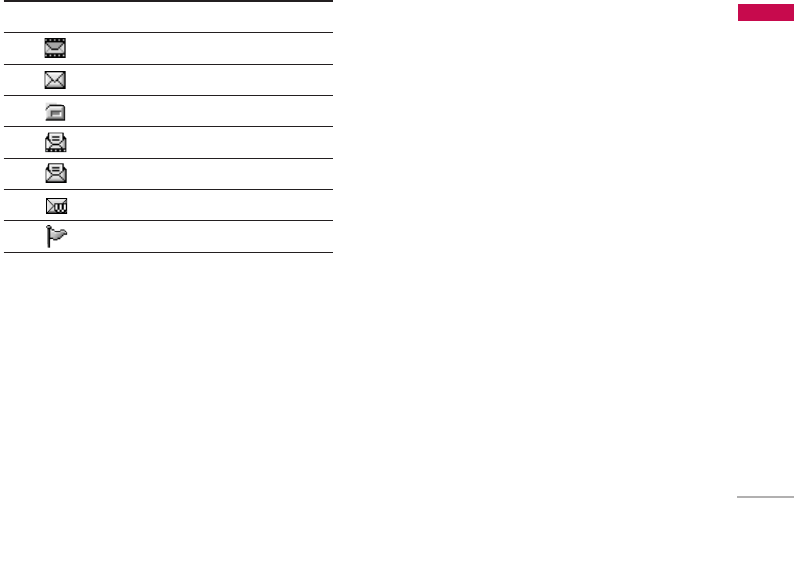
57
If the phone shows 'No space for SIM message', you
have to delete only SIM messages from Inbox. If the
phone displays 'No space for message', you can make
space of each repository as deleting messages, media
and applications.
Instead, when the telephone's internal memory is full,
the message "Message memory full" is shown. In the
same way you must delete some messages in order to
save others.
When notification of multimedia messages is
received, these messages must be downloaded from
the server. See (Menu 5.0.2) for information about
telephone configuration.
To read a message, select the message and press
[OK]. The following menu can be accessed by
pressing the key [Options]:
]View: You can view the received messages.
]Delete: You can delete the current message.
]Reply: You can reply to the sender.
]Forward: You can forward the selected message to
another party.
]Return call: You can call back to the sender.
]View information: Lists information related to the
message shown such as sender's address, subject,
time and day of the message, message type and
size.
]Delete all read messages: Deletes all read
messages.
]Delete all: Deletes all messages.
* Specific MMS options
Messages
Icon Icon directive
Multimedia message
Short message
SIM message
Read multimedia message
Read text message
Push message
Notified multimedia message

Messages
58
]Repeat: Allows you to repeat reproduction of the
selected multimedia message.
]Receive: (for multimedia message notification
only). Multimedia messages, unlike text messages,
must be downloaded from the server automatically
or manually (see (Menu 5.0.2.5)). The network
initially sends multimedia message notification: If
the Auto Download option (Menu 5.0.2.5) is off
or an error has occurred, receipt must be
confirmed by selecting [Receive]. If the Auto
Download option is on, the message is
automatically downloaded after receipt of
notification.
]Cancel: Interrupts multimedia message download
(only when multimedia messages are being
received).
* Specific download message options
]Information: Shows the content of download
messages.
]Load: Launches the WAP connection to the URL
contained in the download message. The
telephone must be configured for WAP services
(Menu 4.1.4) to use download messages.
Orange Messenger Menu 5.3
For Instant Messaging users, a valid User ID and
Password will be required in order to login and
exchange messages as well as checking the online
status.
Offline Menu
Login
This allows users to login by filling in the User ID and
Password.
Saved Conversations
This is where a user can view saved conversations.
Settings
]Screen Name: You may select the Screen Name to
be used while in the Group chat service.
Messages
Note
]There is no need to type the User ID and
Password all the time if only Login process is
successful and they are saved. This feature is
optional.

59
]Availability: You may select your availability status
(Available to Not Available, vice versa).
]Status Text: You may set your current status in
free text format.
]Save Password: You may save your password in
Login input.
]Power-on Login: You may start login automatically
after 20 seconds or so on power-on if you save a
valid password and then reset your mobile.
]Connection: You may set your IM connection
information. But, please check with your Network
provider before changing this information.
When you select Binding Protocol as HTTP
- WV Server: You can change the WV Server
address.
- Internet Profiles: You can change internet
connection settings.
IM Information
Instant Messaging Client Information (Client Name,
Version Number) is displayed.
Online Menu / 1 to 1 conversation
After successful Login, a contact list with contacts
will appear on screen.
Depending on the cursor location in the contact list,
following menu options will be available.
When cursor is located on a Conversations List
]View/Hide Conversations: This provides the
option to view or hide contacts from the selected
list.
]Saved Conversations: You may view or delete the
stored conversation session.
Messages
Note
]Conversations List contains not only contact
which conversation is already opened but also
unknown contact.
Note
]When you select left/right navigation Key or
Confirm Key on the Contact List, it offers the
ability to view or hide conversations.

Messages
60
]Settings
- Screen Name: You may select the Screen Name
to be used while in the Group chat service.
- Availability: You may select your availability
status (Available to Not Available).
- Status Text: You may set your current status in
free text format.
- View Options: You may offer the ability to show
all contacts or only online contacts.
]Logout: This begins the Logout process.
When cursor is located on a Conversation
]View/Hide Conversation: View allows you to
converse with the selected Unknown Contact and
contact which conversation is already started. It
shows conversation of the contact which
conversation is already started.
]End Conversation: This close the selected
conversation. If an unknown contact was selected,
that contact is deleted also.
]Block contact: This blocks the selected Contact.
]View Information: This allows you to view
information. It provides User ID, Mood, Status
Text.
]Refresh Contact: This refreshes the presence
information of the selected contact.
]Settings: Please refer to the previous Settings
Menu.
]Logout: This begins the Logout process.
When cursor is located on a Contact List
]View/Hide Contact: This provides the option to
view or hide contacts from the selected list.
]Add List: This adds a new contact list.
]Add Contact: This adds a new contact to the
selected contact list, in the meantime this searches
contact on the basis of E-mail Address, First Name,
Last Name.
Messages
Note
]The device only can support a maximum of 30
contacts and therefore not all their contacts will
be visible on the phone if they have more than
30.

61
]Send to Other: You can send the contact
information to others.
]Delete List: This deletes the selected contact list.
]Refresh List: This refreshes the presence
information of the contacts within the contact list.
]Settings: Please refer to the previous Settings
Menu.
]Logout: This begins the Logout process.
When cursor is located on a Contact
]Chat/View: Chat will display a screen where
conversation with selected Contact can take place
/ View shows conversation of the contact which
conversation is already started.
]Rename Contact: You can change a selected name
within the contact list.
]Block Contact: This blocks the selected Contact.
]Add Contact: This adds a new contact to the
selected contact list, in the meantime this searches
contact on the basis of E-mail Address, First Name,
Last Name.
]Delete Contact: This deletes the selected
Contact.
]View Information: This allows you to view
information. It provides User ID, Mood, Status
Text.
]Refresh Contact: This refreshes the presence
information of the selected contact.
]Settings: Please refer to the previous Settings
Menu.
]Logout: This begins the Logout process.
Menu options available in the Conversation screen
]Send: Typed message can be sent.
]Back To List: This brings the screen back to the
contact list.
]End Conversation: This ends the active
conversation and clears the conversation buffer.
]Save Conversation: Stores currently active
conversation.
]Add T9 dictionary: You can add your own word.
This menu can be shown only when the edit mode
is Predictive.
Messages

Messages
62
]T9 Languages: Select the language for T9 input
mode.
Drafts Menu 5.4
You can view the messages saved as a draft. The draft
messages are listed with the date and time when they
were saved.
The following options are available.
]View: Shows the selected message.
]Delete: Deletes the message you choose.
]Edit: Modifies the massage you choose.
]View information: To view the information of the
message.
]Delete all: Deletes all of the messages in the
folder.
Mailbox Menu 5.5
You can check the saved emails, drafts, outbox, and
sent emails. In the Inbox, up to 20 emails are stored.
Outbox Menu 5.6
You can see sent and unsent messages here. For sent
message, you can see the delivery status.
The browsing is same as that for the inbox message.
Messages
Note
]Within the conversation screen, you can insert
Symbol, Emoticon and Text Template by using
the right soft key.
]In the conversation window, you can use a side
key or up/down navigation key for scrolling
conversation.
]Maximum number of characters supported by a
message is 500 characters for receiving and
160 characters for sending.
]The presence information might not update in
real time so the “Refresh List”/”Refresh
Contact” option can be used for most up to
date status.
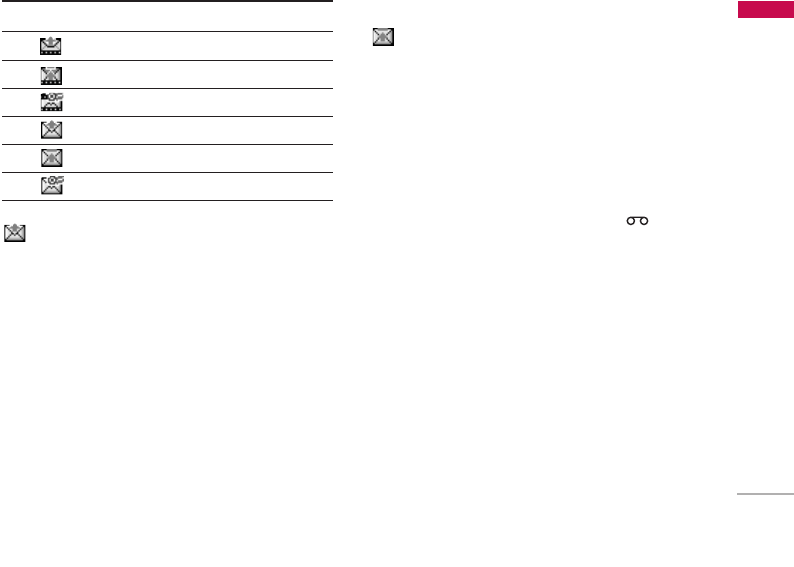
63
Messages sent correctly feature the following
options.
]View: Shows the selected message.
]Delete: Deletes the selected message from the
Sent folder.
]Edit: Modifies message you chose
]Send: Allows you to send the message again
]View information: Allows you to view information
about the sent message such as sender°Øs
address, attachments (for multimedia messages
only), date and time of message transmission,
message type and size.
]Delete all: Deletes all messages in the Sent folder.
Messages being sent feature the following
icons.
Listen to voice mail Menu 5.7
This menu provides you with a quick way of accessing
your voice mailbox (if provided by your network).
Before using this feature, you must enter the voice
server number obtained from your network operator.
When new voice message is received, the symbol
will be displayed on the screen. Please check with
your network provider for details of their service in
order to configure the handset correctly.
Info message Menu 5.8
(Dependent to network and subscription)
Info service messages are text messages delivered by
the network to GSM. They provide general
information such as weather reports, traffic news,
taxis, pharmacies, and stock prices. Each type of
information has the number; therefore, you can
contact service provider as long as you have input
the certain number for the information. When you
Messages
Icon Icon directive
MMS Sent
MMS Unsent
MMS delivery confirmed
SMS sent
SMS unsent
SMS delivery confirmed

Messages
64
have received an info service message, you can see
the popup message to show you that you have
received a message or the info service message is
directly displayed.
To view the message again or not in standby mode,
follow the sequence shown below;
Read (Menu 5.8.1)
1. When you have received an info service message
and select Read to view the message, it will be
displayed on the screen. You can read another
message by scrolling , or [Next].
2. The message will be shown until another message
is reached.
Topics (Menu 5.8.2)
(Dependent to network and subscription)
]Add new: You can add Info service message
numbers in the Phone memory with its nickname.
]View list: You can see Info service message
numbers which you added. If you press
[Options], you can edit and delete info message
category which you added.
]Active list: You can select info service message
numbers in the active list. if you activate an info
service number, you can receive messages sent
from the number.
Templates Menu 5.9
Templates are preset messages used to speed up the
writing of common messages. The available templates
and options are listed below.
Text (Menu 5.9.1)
Some text templates are available for which the
following options can be accessed.
]View: Shows selected template.
Messages
Note
]Enablement of info messages may cause a
reduction in the duration of the battery in
stand-by mode.

65
]Delete: Deletes selected template.
]Add new: Allows you to create a new template.
]Send via: Allows you to send selected template via
SMS or MMS.
]Edit: Edits selected template.
]Delete all: Deletes all text templates.
Multimedia (Menu 5.9.2)
You can use the following options.
]View: You can see multimedia templates.
]Delete: You can delete multimedia templates.
]Add new: Allows you to add new multimedia
templates.
]Send via multimedia message: You can write and
send multimedia messages.
]Edit: You can edit multimedia templates.
]Delete all: Allows you to delete all multimedia
messages.
Business card (Menu 5.9.3)
This option allows you to create your own business
card featuring Name, 4 numbers and an email
address. To create a new business card, press the left
soft key [Add] and enter the information into the
fields. If a business card is already available, the
following menu can be accessed by pressing the left
soft key [Options]:
]Edit: Edits business card.
]Send via: Allows you to send business card via
SMS or MMS.
]Delete: Deletes business card.
Settings Menu 5.0
Text messages (Menu 5.0.1)
This menu allows you to configure preset information
of text messages.
]Message centre number: If you want to send the
text message, you can receive the address of SMS
centre through this menu.
Messages

Messages
66
]Message types
Text, Voice, Fax, Natl. Paging, X.400, E-mail,
ERMES Usually, the type of message is set to Tex t .
You can convert your text into alternative formats.
Contact your service provider for the availability of
this function.
]Validity period: This network service allows you to
set how long your text messages will be stored at
the message centre.
]Delivery report: If you set to Yes, you can check
whether your message is sent successfully.
]Reply via same message centre: When a message
is sent, it allows the recipients to reply and charge
the cost of the reply to your telephone bill.
Multimedia messages (Menu 5.0.2)
Use this menu to configure preset information of
multimedia messages.
]Priority: You can set the priority of the message
you choose.
]Message subject: You can enter multimedia
messages subject when this menu is on.
]Validity period: This network service allows you to
set how long your text messages will be stored at
the message centre.
]Delivery report: If it is set to Yes in this menu, you
can check whether your message is sent
successfully.
]Auto download
- Always on: Multimedia messages are
automatically downloaded upon receipt of
notification if this option is selected.
- Manual: The telephone asks whether or not to
go ahead with the download when notification of
a new multimedia message is received.
- Home network only: Messages are only
downloaded automatically when with your own
operator if this option is selected. If in roaming
mode, confirmation will be requested if you wish
to download the message.
- Off: Notification only will be received if this
option is selected.
Messages

67
]Access point: A data connection via data call
(CSD) using the GPRS or the even faster EDGE
service (see the Internet section for more
information about EDGE) is needed to download
multimedia messages from the server. Up to 5
connection profiles can be set for multimedia
messages.
The following menu can be accessed by pressing
the left soft key [Options] on the profile of your
choice:
]Activate: Enable the selected profile and makes it
ready for use.
]Settings: Enter the MMS server connection data
provided by your operator or service provider.
- Homepage
Set the multimedia message service centre
(MMSC).
- Bearer
Data
GPRS
- Data settings
This is only shown if you select Data as the
connection service.
IP address: Enter the multimedia service centre IP.
Dial number: Enter the telephone number to be
used for the connection.
User id: User id for own server connection (NOT
WAP gateway user ID).
Password: Password requested by own server
connection (NOT by WAP gateway) for
identification purposes.
Call type: Select the type of data call - analogical
or digital (ISDN).
Call speed: Set the connection speed for data -
9600 or 14400.
Linger time: Set the length of time after which
the phone must disconnect itself if no data have
been transferred.
- GPRS setting
This menu is only shown if you select GPRS as
the connection service.
IP address: Enter the multimedia service centre IP.
APN: Enter the APN (Access Point Name) of the
GPRS.
Messages

Messages
68
User id: Enter User id for server connection.
Password: Enter the password requested by the
server.
- Connection type
Select whether the connection must be
Permanent or Temporary.
- Secure settings
Decide whether or not the telephone must have a
secure connection.
] Rename: Changes the name of the selected
profile.
]Permitted message types
- Personal: Personal message.
- Advertisements: Commercial message.
- Information: Necessary information.
Email (Menu 5.0.3)
This menu allows you to edit, delete or add and email
account.
You can set up to 3 email accounts. To create your
own email account, you will need to enter an ID and
password.
1. Select an account.
2. Select Edit and scroll to Incoming ID/PWD.
3. Enter your ID and password.
Voice mailbox number (Menu 5.0.4)
You can input and set the voice mailbox number.
The following submenus are available:
]Home: Enter the message answering number to be
used when on the national network.
]Roaming: Enter the message answering number to
be used when in international roaming mode.
Info message (Menu 5.0.5)
]Receive
Yes
If you select this menu, your phone will receive Info
service messages.
No
If you select this menu, your phone will not receive
Info service messages any more.
Messages
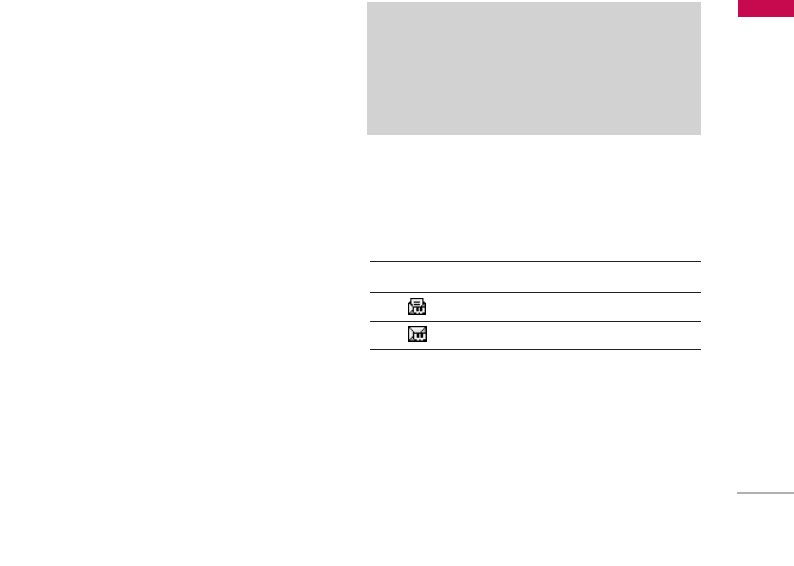
69
]Alert
Yes
Your phone will beep when you have received Info
service message numbers.
No
Your phone will not beep even though you have
received info service messages.
]Languages
You can select the language you want by pressing
[On/Off]. Then, the info service message will be
shown in the language that you selected.
Download messages (Menu 5.0.6)
You can order push messages from WAP service
providers. Push messages are notifications of, for
example, news headlines and they can contain a text
message or the address of a WAP service. For
availability and subscription, contact your WAP
service provider.
]Service: You can set on/off the reception of the
push messages.
]Automatic download: If you set on, reception of a
new push message starts the connection to WAP
atomatically.
After selecting a push message, the following menus
are available.
- Information: Shows the information of the current
push message.
- Load: Connects to a specific site using the
information in the current push message.
Messages
Note
]Service providers can update an existing push
message with a new incoming push message.
(Old one will be replaced with new one.)
When push messages expire, they are deleted
automatically.
Icon Description
Read Push Message
Unread Push Message

Messages
70
- Delete: Deletes the current push message.
- Delete all read messages: Deletes all read
messages.
- Delete All: Deletes all the messages in inbox
(including SMS, MMS, etc.)
Memory status Menu 5.*
You can check free space and memory usage of each
repository, SIM memory. You can go to each
repository menu.
Messages

Orange World
71
One click to your new Orange World
Just one click on your new S5300 transports you to
the latest games, ringtones and sports news from
around the world.
Find your nearest cashpoint then pick out a bar to
blow your wages in, or simply curl up on the sofa and
read about your favourite celebrities. Or, if you’re
feeling lucky, why not enter one of our great
competitions. Whatever your mood, you’re bound to
find something of interest in your Orange World, so
take the leap and get exploring now!
To enter Orange World press Orange. Orange World
will open. Scroll down the page and press Select
when you come to a link you want to visit. Channels
enables Orange to suggest links that you’ll enjoy, the
suggestions we make are based on your phone and
the day of the week. For example, on a Saturday we
may suggest sport to give you quick access to
football results.
Use Channels to personalise your phone by
downloading new ring tones, wallpapers, or the latest
games, including some of the biggest games around
such as Fifa Football and Tiger Woods Golf. You can
even send Purple Ronnie greeting cards to send a
surprise message to your friends. You can also access
services from other providers such as the BBC and
RAC.
How to create your own Orange World
The great thing about using Orange World is that
you can constantly update it to suit your interests.
When you first enter Orange World, spend a minute
or two completing the Orange World wizard, which
will ask you about your interests in order to provide
the most relevant services to you. To set up your
Orange World wizard, click the link under Your Page.
Once you have finished personalising, use the Your
Page link to quickly go to services which are of
interest to you.
You can add or delete links to Your Page using the
simple options provided. A suggestion for a link that
might be useful will also appear at the top of the
Orange homepage each time that you begin
browsing.
Orange World

Orange World
72
How to find your way using Orange World
There’s nothing more annoying than being lost or
not having the right number to hand. You can now
put these frustrations behind you with a dedicated
Find feature which will show you where you are or
take you to a list of sites, such as Time Out, to help
you find the information you need to keep working
or partying.
For example, use Orange World to find the nearest
cash point to the pub you arranged to meet your
friends in. Once you’re there, use the Find feature to
find the local cinema, and grab a cab number to
organise a lift there. It’s simple, quick, and above all
convenient. Try it now to see what you could be
doing tonight.
Orange World

Music player
73
MP3 player Menu 7.1
1. Press MP3 menu, and then select MP3 player.
2. Press the left soft key [Options] to access
the following menus.
]View play list: You can view the play list on
listening to the music.
]Area repeat: The special area part of the current
music is repeated when you select ON of the
menu.
]Set as ring tone: This menu allows to set the MP3
file as a ring tone. You can also set it as a ring tone
in Profile.
]Setting
- Equalizer
This menu helps you to adjust a varity of
environment on listening to the music. This
phone supports four preset menus. When you
enter this menu, you can view current value of
equalizer.
- Playmode
This menu allows to set the play mode.
- Set shuffle
You can listen to MP3 music all randomly.
- Visual effect
You can select the visual effect menus: Wave,
Guitarist,.Aqua. This menu allows to changethe
backgroud of main LCD and sub LCD on playing
MP3 file.
Playlist (Menu 7.1.1)
This menu allows to view the whole play list. You can
move the track by pressing the navigation key.
In addition, if you select option menu, you can delete
the file or view its information .
Music player
Note
]The copyright of music files can be protected in
international treaties and national copyright
laws. Therefore, it may be necessary to obtain a
permission or a license to reproduce or copy
music. In some countries national law prohibits
private copying of copyrighted material. Before
downloading or copying the file, please check
the national legislation of the applicable
country concerning the use of such material.

Music player
74
Settings (Menu 7.1.2)
This menu allows to set the following items; Equalizer,
Playmode, Set shuffle and Visual effect.
Music player

My folder
75
Photo gallery Menu 8.1
All the still images taken in the Take Photo menu are
stored in this menu. You can view, organise and send
the pictures saved in your phone.
Select the picture you want press the left soft key
[Options] to access the following submenus.
]Open: You can view one image at a time.
]Delete: Delete the selected image.
]Set as wallpaper: You can set the selected image
as the LCD wallpaper.
]Set as Photo ID: You can add the selected image
to a address book contact to use the Photo Caller
ID feature.
]Send via multimedia message: You can send the
selected image via a multimedia message.
]Edit: (Shown in the normal view) After selecting
the normal view of an image, you can edit it as
follows. After editing, the changed image can be
saved by pressing the left soft key [Save]. And the
original image is retained.
- Effect filters: You can give various effects to the
image. After selecting the desired effect from 12
effect filters using the left/right navigation key,
press the left soft key [Save]. The changed image
is stored.
]Rotate: You can rotate your picture.
]Rename: You can change the name of the selected
image.
]Delete all: Deletes all the images in your phone.
]Information: You can check the title, resolution,
size, and date and time of the selected image.
Video gallery Menu 8.2
Select the desired video clip using left / right / up /
down navigation keys, you can access the following
submenu using the left soft key [Options].
]Open: Plays the selected video clip.
]Delete: Deletes the selected video clip.
]Rename: You can change the title of the selected
video clip.
My folder

My folder
76
]Playback: You can play video clip with below
option.
- Once: play the selected video clip only one time.
- Repeat: play the selected video clip repeatedly.
- Continuous: play the all the video clip in your
phone continuously.
]Delete all: Deletes all the video clips in your
phone.
]Information: You can check the title, size, playing
time and date and time of the selected image.
Music Menu 8.3
Show the list of MP3, MP4, AAC, M4A, WMA files at
My media\Music in Multimedia memory.
] Play: You can play the MP3 file when pressing OK
key or selecting Play menu of Option menu.
]Delete: Delete a file.
]View details: Show the file information.
]Delete all: Delete all files in the list.
Graphics Menu 8.4
The left soft key [Options] will bring up the
following options.
]View: You can see the animated graphics one by
one.
]Send Via: Downloaded Picture can be sent via SMS
and MMS.
]Set as wallpaper: Currently selected Picture can
be set as a Wallpaper.
Ringtones / Audio Menu 8.5
The left soft key [Options] will bring up the
following options.
]Delete: Delete the selected sound.
]Send Via: Melody Sound can be sent via SMS and
MMS.
]Record voice: Set record voice to save a new audio
file to attach to your multimedia message.
]Rename: You can change the name of the selected
sound.
My folder

77
Games & Apps Menu 8.6
For further details, see page 48 (Menu 3.1).
My folder
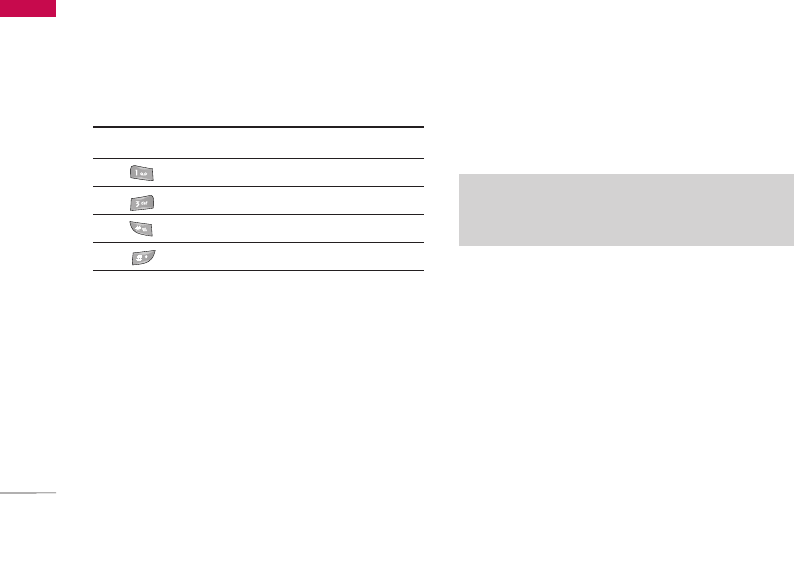
Calendar
78
Scheduler Menu 9.1
When you enter this menu, a calendar appears. A
square cursor is located on the current date. You can
move the cursor to another date using navigation
keys. On the calendar, you can use the following keys.
You can enter a schedule or memo in the scheduler
by pressing the left soft key [Options].
Visible menus on Calendar
]View daily schedules: Shows the note for the
chosen day. Use the up/down navigation keys to
browse through the note lists. If you set alarm for
the note, Alarm watch is displayed. At that time, if
you press the left soft key [Select], you can see
the note in detail. Press the left soft key[Options]
to delete, edit the note you selected. With your
Left or Right Navigation keys, you go to previous
or next day.
]Add new: Allows you to enter up to 20 new events
or memos in the calendar. A subject, time and
repetition can be entered for each note and an
alarm set (for details see [Menu 7-1]. After linking
a note to a date, the date is underlined and marked
with an icon in the bottom right of the screen.
]View all schedules: Shows the notes that are set
for all days. Use up/down navigation keys to
browse through the note lists. You can use the
same menu as "Day view" by select key pressing
the right soft key [Options].
]Delete past: You can delete the past schedule that
has been already notified you.
]Delete all: You can delete for the all note(s).
]Go to date: Typing a date, you can go to the date
directly.
Calendar
Icon Description
skips back a year.
skips forward a year.
skips back a month.
skips forward a month.
Note
]The alarm feature only works if the telephone is
switched on.

79
]Set alarm tone: You choose a scheduler alarm
tone on the list showing.
Memo Menu 9.2
1. Select a memo pad you would edit.
2. If being a (Empty), Write by pressing the left soft
key [Select].
3. Input the memo and then press the left soft key
[OK].
Calendar

Games & Apps
80
Java is a technology developed by Sun Microsystems.
Similar to the way you would download the Java
Applet using the standard Netscape or MS Internet
Explorer browsers, Java MIDIet can be downloaded
using the WAP enabled phone. Depending on the
service provider, all Java based programs such as Java
games can be downloaded and run on a phone.
Once downloaded, the Java program can be viewed
within the Games & Apps menu where you can
select, execute or delete. The Java program files saved
in the phone are in .JAD and .JAR formats.
Games & Apps Menu 10.1
Main Screen, Java' main menu, has a Preinstalled
folder already created, and adds it to the list when a
new folder is created or downloaded games are
stored.
After selecting a downloaded game, and then press
Options, sub menus available to several options
(Open, Information, Send Information, Update,
Rename, Permissions, Authentication, New folder and
Move) are displayed.
]Open: Launch the game.
]Delete: Remove the game.
]Rename: Rename the game.
]New folder: Create a new folder.
Games & Apps
Note
]The JAR file is a compressed format of the Java
program and the JAD file is a description file that
includes all detailed information. From the network,
prior to download, you can view all detailed file
descriptions from the JAD file.
]While being based on a standard language (J2ME),
not all Java applications are compatible with all
handsets on sale insofar as specific libraries may be
used for a telephone model. The software may be
blocked or switch itself on when Java applications
not specifically developed for the phone this
manual refers to are downloaded, making it
necessary to "restart" the handset. We would like
to point out that these problems are caused by
incompatible applications and are not a product
fault.
Warning
]
Only J2ME (Java 2 Micro Edition) based programs
will run in a phone environment.
]
The J2SE (Java 2 Standard Edition) based programs
will only run in a PC environment.

81
More games Menu 10.2
Connects to Orange. You can download games using
the WAP. And they are stored in Games & Apps.
Accounts Menu 10.3
You can select one of the defualt accounts and add
new one also.
Games & Apps

Profiles
82
In Profiles, you can adjust and customise the phone
tones for different events, environments, or caller
groups. There are five preset profiles: Vibrate only,
Quiet, General, Loud and Headset. Each profile can
be personalised. Press the left soft key [Menu] and
select Profiles using up/down navigation keys.
Activate Menu 11.1
1. A list of profiles is displayed.
2. In the Profiles list, scroll to the profile you want to
activate and press the left soft key [OK] or
OK key.
3. Then, select Activate.
Personalise Menu 11.2
Scroll to the desired profile in the Profile list. After
pressing the left soft key or the OK key, select
Personalise. The profile setting option opens. Set
the options as required.
]Call alert type: Set the alert type for incoming
calls.
]Ring tone: Select the desired ring tone from the
list.
]Ring volume: Set the volume of the ringing tone.
]Message alert type: Set the alert type for
messages.
]Message tone: Select the alert tone for messages.
]Keypad tone: Select the desired keypad tone.
]Keypad volume: Set the volume of keypad tone.
]Slide tone: Allows to set the slide tone for
adjusting environment.
]Effect sound volume: Set the volume of effect
sound.
]Power on/off volume: Set the volume of the
ringing tone when switching the phone on/off.
Profiles
Note
]To protect the sense of hearing while Slide
open, maximum volume level is 3.

83
]Auto answer: This function will be activated only
when your phone is connected to the headset.
• Off: The phone will not answer automatically.
• After 5 secs: After 5 seconds, the phone will
answer automatically.
• After 10 secs: After 10 seconds, the phone will
answer automatically.
Rename Menu 11.3
You can rename a profile and give it any name you
want.
1. To change the name of a profile, scroll to the
profile in the profile list and after pressing the left
soft key or the OK key, select Rename.
2. Key in the desired name and press the OK key or
the left soft key [OK].
Profiles
Note
]Vibrate only, Silent and Headset profiles
cannot be renamed.

Extras
84
Bluetooth Menu 12.1
Bluetooth enables compatible mobile devices,
peripherals and computers that are in close proximity
to communicate directly with each other without
wires. This handset supports built-in Bluetooth
connectivity, which makes it possible to connect
them with compatible Bluetooth headsets, computer
applications and so on.
When you receive data from another Bluetooth
device, the phone requests for a confirmation. After
confirming the transfer, the file will be copied in your
phone.
Depending on the file type, it will be stored in the
following folders:
]MP3: MP3 folder (Menu 6.5.2)
]Video (.3GP): video folder (Menu 6.4)
]Phonebook contacts (.VCF): Phonebook
(Menu 4.1.1)
]Other files: File storage folder (Menu 9.4)
My devices (Menu 12.1.1)
You can view all devices which are compatible with
your Bluetooth phone.
Handsfree devices (Menu 12.1.2)
You can view the list of handsfree devices which are
compatible with your Bluetooth phone.
Settings (Menu 12.1.3)
You can register a new device which is compatible
with Bluetooth. If you already have added the device,
you can connect to it after entering a password
(usually 0000).
Extras
Note
]Due to a compatibility problem, some devices
may not support this function.
]Supported Bluetooth software (Bluetooth
stacks) for DUN :
- WIDCOMM Bluetooth for Windows 1.4 and
3.0

85
Alarm clock Menu 12.2
You can set up to 5 alarm clocks to go off at a
specified time.
After selecting an alarm clock using the left soft key
[Select],
1. Alarm on/off: Select On using the left/right
navigation key. To deactivate the alarm function,
select Off.
2. Alarm time: Enter the alarm time using the
numeric keys.
3. Repeat: Select the desired one from Once,
Mon~Fri, Mon~Sat, and Everyday using the
left/right navigation key.
4. Alarm melody: Select the desired alarm
melody using the left/right navigation key.
5. Press the left soft key [OK].
6. You can edit the alarm clock name. After keying in
the name, press the left soft key [OK].
When an alarm function is activated, “ ” is shown
in standby mode.
When the alarm time is reached, it sounds the alarm
melody.
]To turn off the alarm, press the right soft key
[Quit].
1. Select On and enter the alarm time you want.
2. Select the repeat period : Once, Mon~Fri,
Mon~Sat, Everyday.
3. Select the alarm tone you want and press the left
soft key [OK].
4. Edit the alarm name and press the left soft key
[OK].
Extras
Note
]Wake up alarm works only when the phone is
on.

Extras
86
Voice recorder Menu 12.3
The voice memo feature you to record up to 10 voice
messages and each memo is up to 20 Seconds.
Record (Menu 12.3.1)
1. Once recording is started, the message Recording
and the remaining time is displayed.
2. If you want to finish recording, press the left soft
key [Save].
3. Key in Voice memo title, press the left soft key
[OK].
View list (Menu 12.3.2)
The phone shows voice memo list. You can Play and
Delete the recorded voice memo.
]Play: Select this menu to listen to the selected
memo.
]Delete: Deletes the recorded memo.
]Record new: Launches recording of new memo.
]Rename: Changes the title of the selected voice
memo.
]Send via multimedia message: Creates a new
multimedia message and attaches the selected
voice memo as an audio file.
]Delete all: Deletes all memos. Press the left soft
key [Yes] to confirm.
Calculator Menu 12.4
This feature allows you to use the telephone as a
calculator able to perform standard arithmetical
functions: addition, subtraction, multiplication and
division (numbers with a maximum of two decimals
may be entered).
Using the calculator
1. Enter the first number of the operation using the
numerical keys.
2. Use the navigation keys to select the function.
Extras
Note
]In standby mode, hold down the ‘ # ’ key to
directly access recording of a new memo.

87
3. Enter the second number and press the left soft
key [Result] or the OK key to calculate the result.
4. After performing the calculation, press the left soft
key [Reset] to reset the calculator.
World time Menu 12.5
This allows you to check GMT (Greenwich Mean
Time) and the time in some of the world’s major
cities by using the left/right navigation keys.
The name of the city, date and local time are shown
on the display screen.
To select the time zone:
1. Select the city corresponding to the time zone by
pressing one or more times the left/right
navigation keys. The date and local time will be
shown.
2. To set the selected time as the time shown on the
display screen when in standby mode, press the
left soft key [Set].
Unit converter Menu 12.6
This converts any measurement into a unit you want.
There are 4 types that can be converted into units:
Length, Area, Weight, and Volume.
1. You can select one of four unit types by pressing
left soft key [Unit].
2. Select the standard value by using left/right
navigation key.
3. Select the unit you want to convert by pressing up
and down navigation.
4. You can check the converted value for the unit
you want. Also, you can input a decimal number
by pressing .
Extras
Note
]To cancel any errors or data on the display
screen press the key. To enter a decimal
point, press the key. To enter a negative
number, press the key.
Note
]A decimal number can be entered by pressing
the ‘ # ’ key.

Technical data
89
General
Product name : S5300
System : GSM 900 / DCS 1800 / PCS 1900
Ambient Temperatures
Max : +55°C(discharging)
+45°C (charging)
Min : -10°C
Technical data
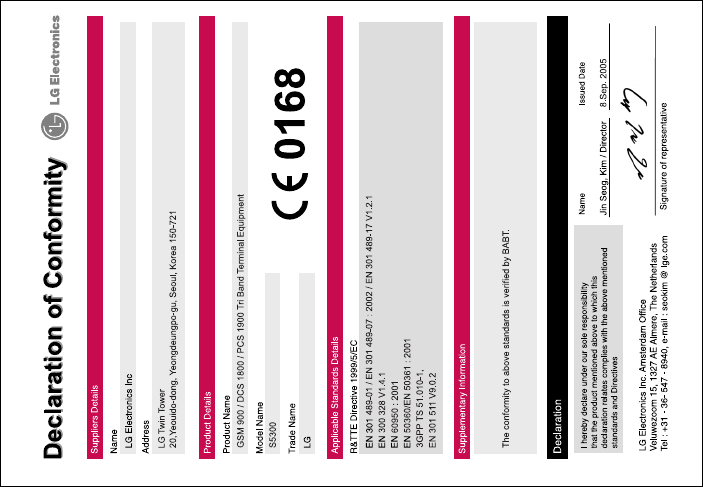

Appendix 1. RF Exposure Statement
WARNING! Read this information before operating the phone.
In August 1996, the Federal Communications (FCC) of the United States, with its action in Report
and Order FCC 96-326, adopted an updated safety standard for human exposure to radio
frequency(RF) electromagnetic energy emitted by FCC regulated transmitters. Those guidelines
are consistent with the safety standard previously set by both U.S. and international standards
bodies.
The design of this phone complies with the FCC guidelines and these international standards.
CAUTION
Use only the supplied and approved antenna. Use of unauthorized antennas or modifications could
impair call quality, damage the phone, void your warranty and/or result in violation of FCC
regulations.
Do not use the phone with a damaged antenna. If a damaged antenna comes into contact with skin,
a minor burn may result. Contact your local dealer for a replacement of antenna.
Body Worn Operation
This device was tested for typical body-worn operations with the back of the phone kept 1.5
cm from the body. To comply with FCC RF exposure requirements, a minimum separation
distance of 1.5 cm must be maintained between the user’s body and the back of the phone,
including the antenna, whether extended or retracted. The use of belt-clips, holsters, and
similar accessories should not containing metallic components in its assembly. The use of
accessories that do not satisfy these requirements may not comply with FCC RF exposure
requirements, and should be avoided.
* This GSM phone has Bluetooth function.
For Your Safety FCC Part 15 Class B Compliance
This device and its accessories comply with part 15 of FCC rules. Operation is subject to the
following two conditions: (1) This device and its accessories may not cause harmful
interference, and (2) this device and its accessories must accept any interference received,
including interference that may cause undesired operation.
Appendix 2. Consumer Information on SAR
(Specific Absorption Rate)
This Model Phone Meets the Government’s Requirements for Exposure to Radio Waves. Your
wireless phone is a radio transmitter and receiver. It is designed and manufactured not to exceed
the emission limits for exposure to radio frequency (RF) energy set by the Federal
Communications Commission of the U.S. Government. These limits are part of comprehensive
guidelines and establish permitted levels of RF energy for the general population. The guidelines
are based on standards that were developed by independent scientific organizations through
periodic and thorough evaluation of scientific studies. The standards include a substantial safety
margin designed to assure the safety of all persons, regardless of age and health.
The exposure standard for wireless mobile phones employs a unit of measurement known as the
Specific Absorption Rate, or SAR. The SAR limit set by the FCC is 1.6 W/kg. Tests for SAR are
conducted using standard operating positions specified by the FCC with the phone transmitting at
its highest certified power level in all tested frequency bands. Although SAR is determined at the
highest certified power level, the actual SAR level of the phone while operating can be well below
the maximum value. Because the phone is designed to operate at multiple power levels to use only
the power required to reach the network, in general, the closer you are to a wireless base station
antenna, the lower the power output.
Before a phone model is available for sale to the public, it must be tested and certified to the FCC
that it does not exceed the limit established by the government-adopted requirement for safe
exposure. The tests are performed in positions and locations (e.g., at the ear and worn on the
body) as required by the FCC for each model.
The highest SAR value for this model phone when tested for use at the ear is 0.122W/kg,
and when worn on the body, as described in this user guide, is 0.486W/kg
(body-worn measurements differ among phone models, depending upon available accessories and
FCC requirements). While there may be differences between SAR levels of various phones and at
various positions, they all meet the government requirement for safe exposure.
The FCC has granted an Equipment Authorization for this model phone with all reported SAR
levels evaluated as in compliance with the FCC RF emission guidelines. SAR information on this
model phone is on file with the FCC and can be found under the Display Grant section of
http://www.fcc.gov/oet/fccid after searching on FCC ID BEJS5300.